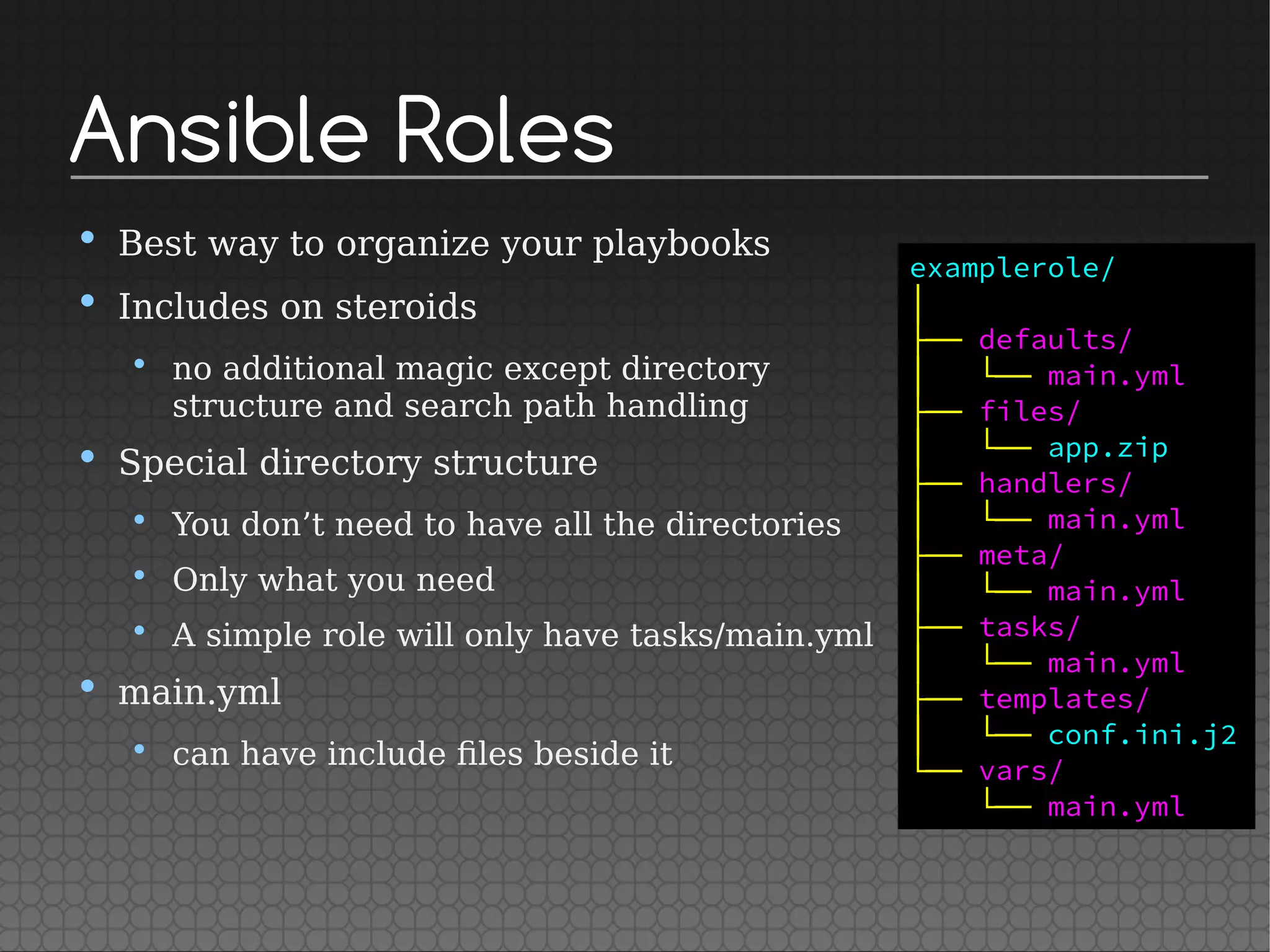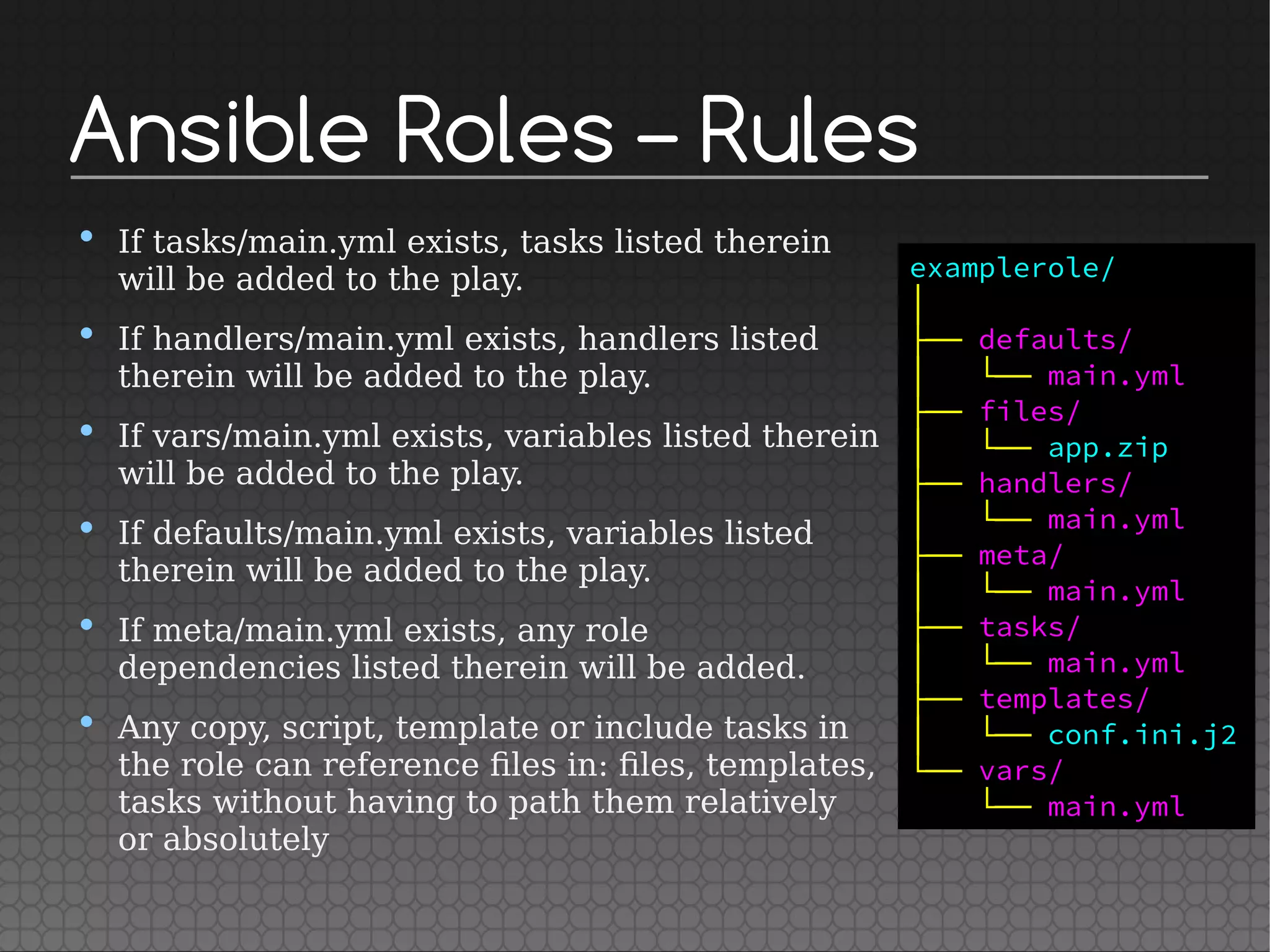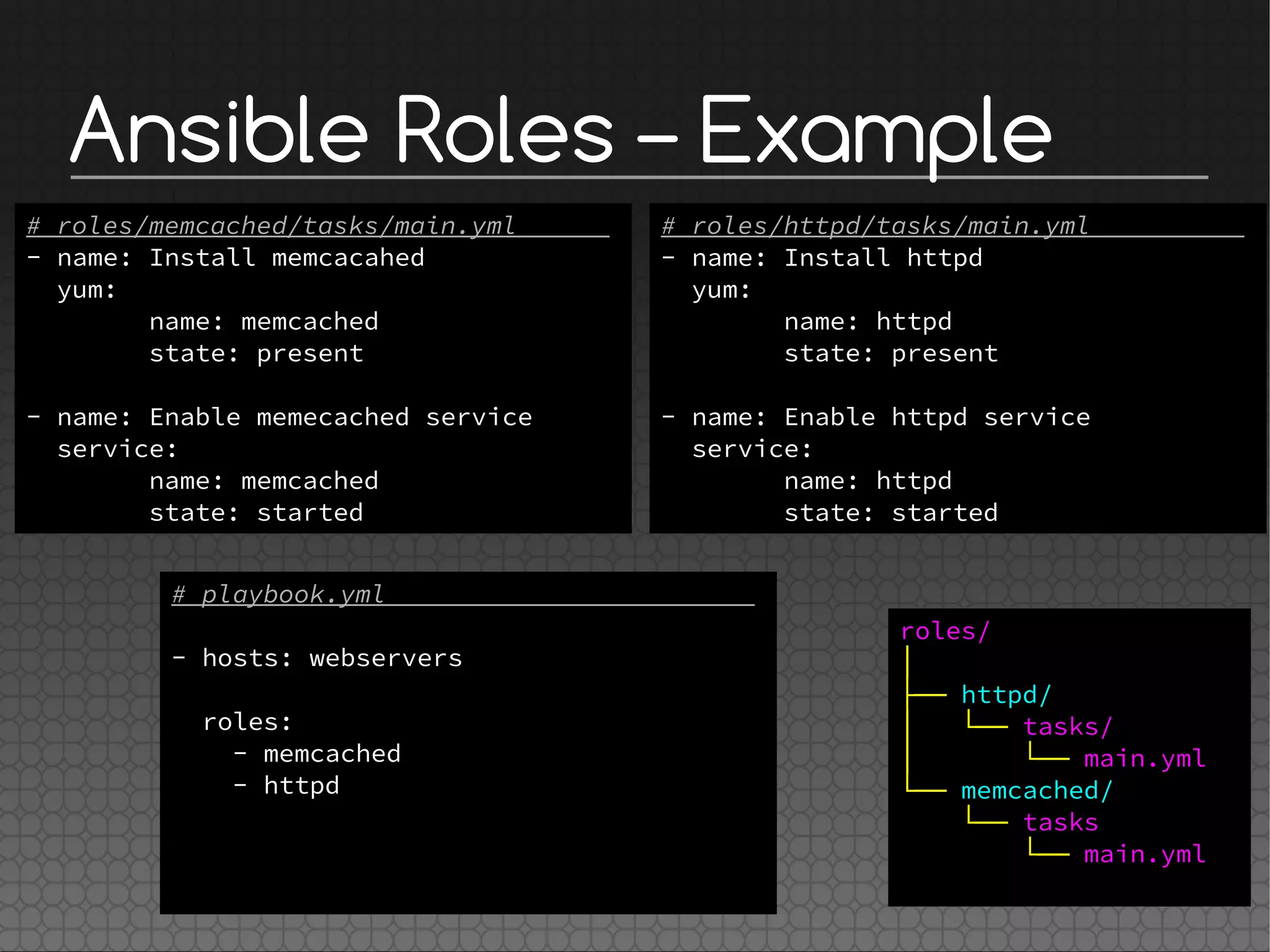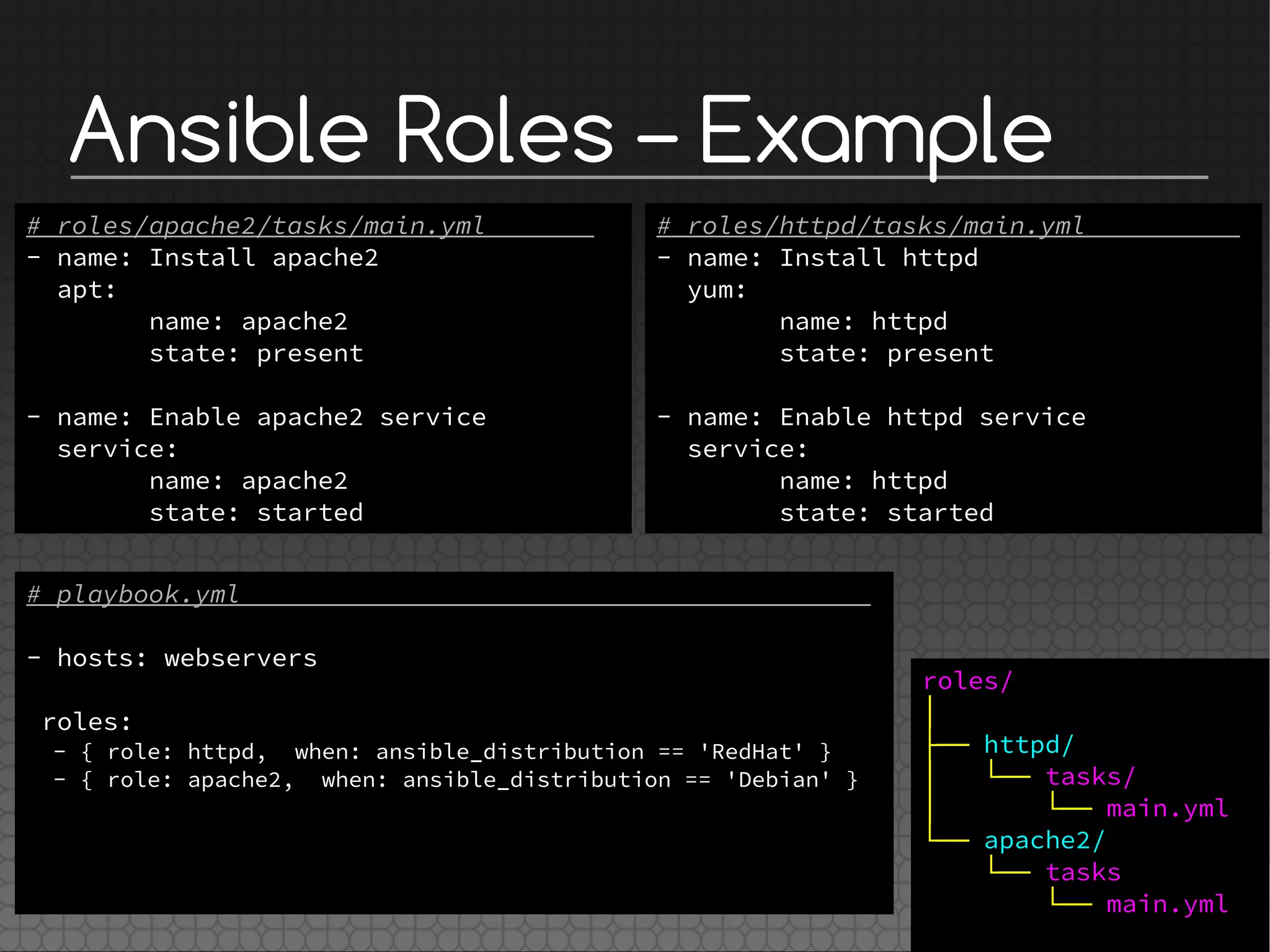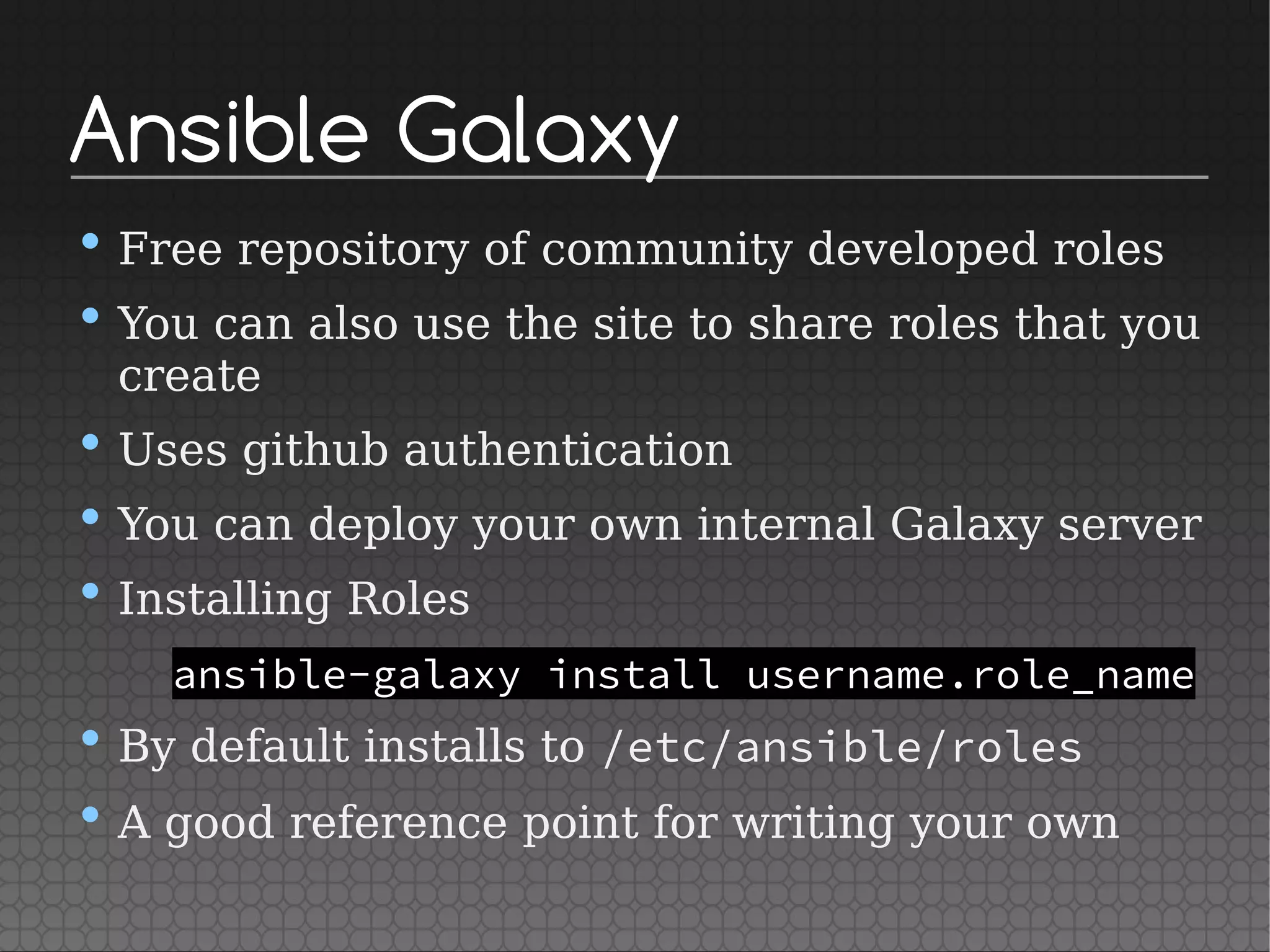This document outlines a hands-on workshop on Ansible by Khizer Naeem, targeting individuals with a basic understanding of Linux and command line. The agenda includes Ansible installation, components, real-world deployments, and advanced topics such as variables and loops. Participants will set up a lab environment, run playbooks, and learn how to manage automation and orchestration tasks with Ansible.





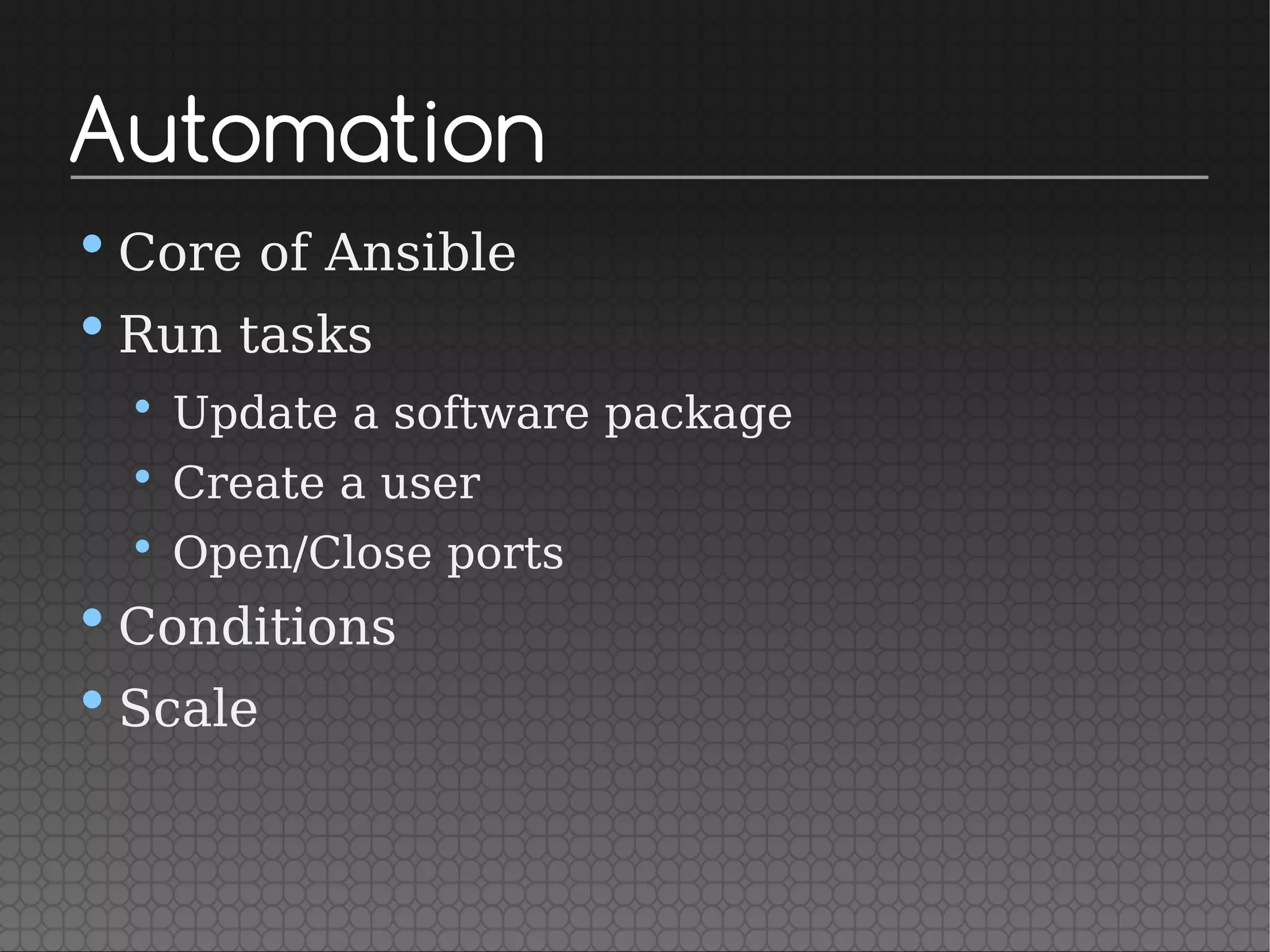
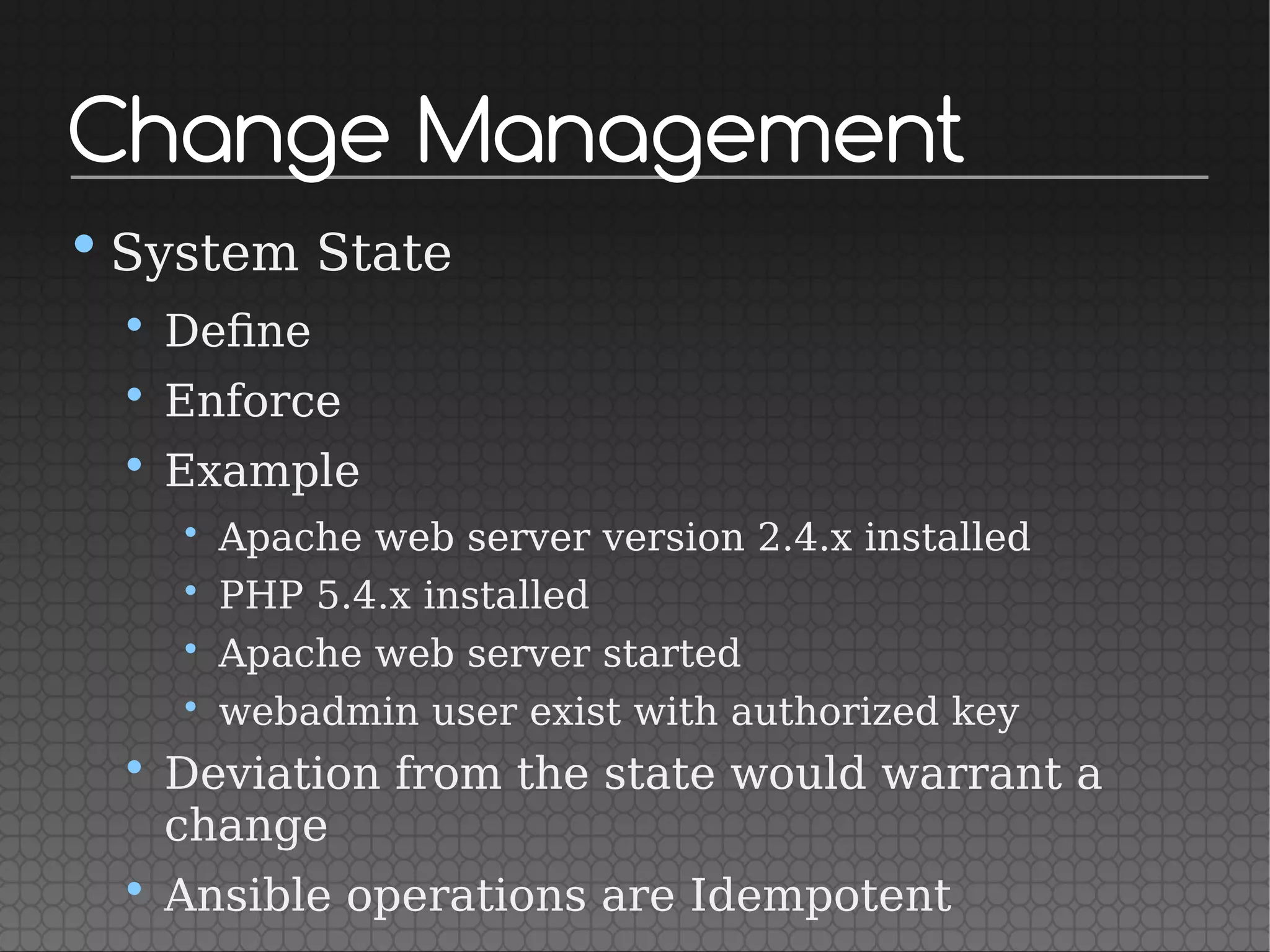
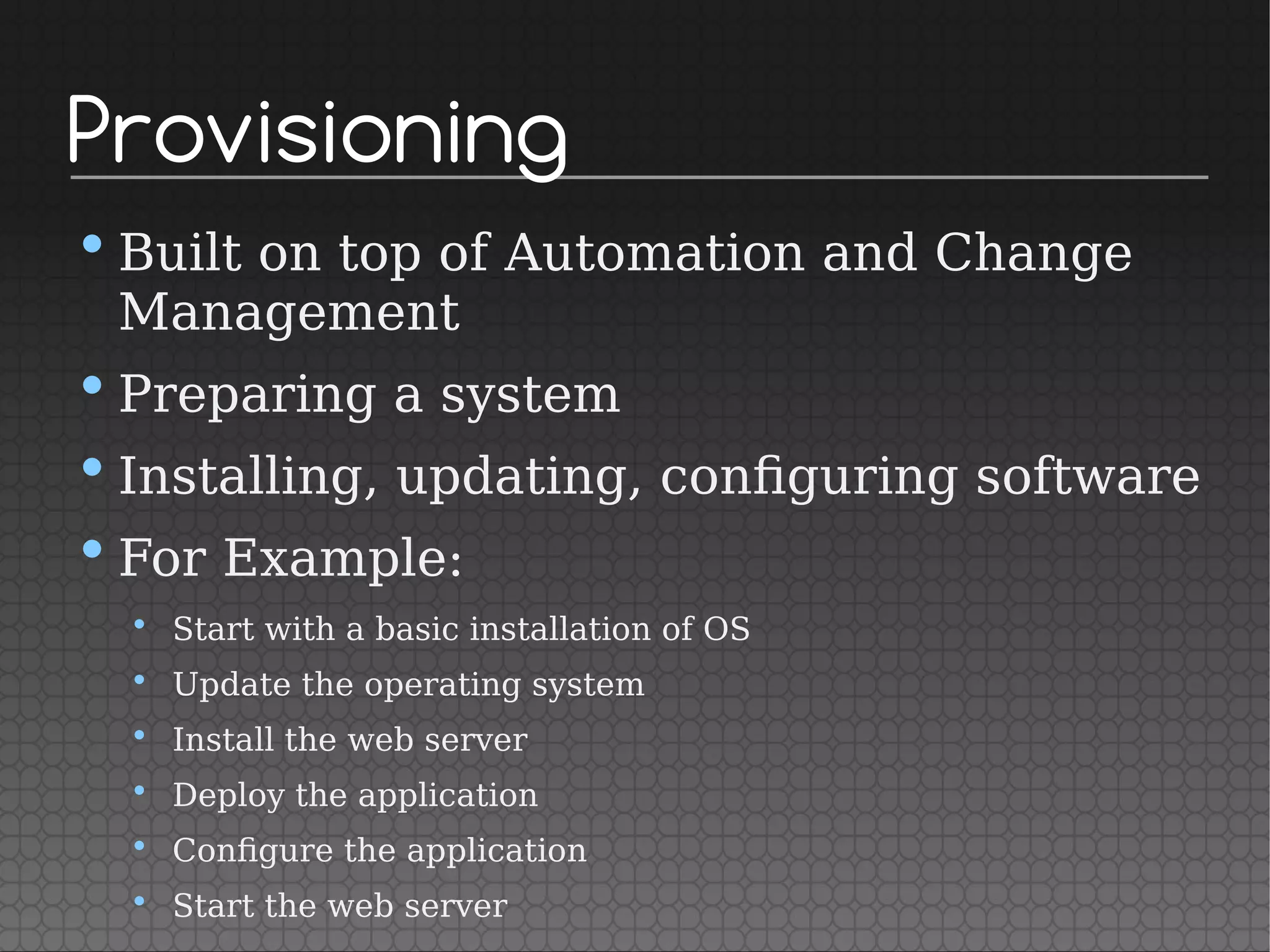
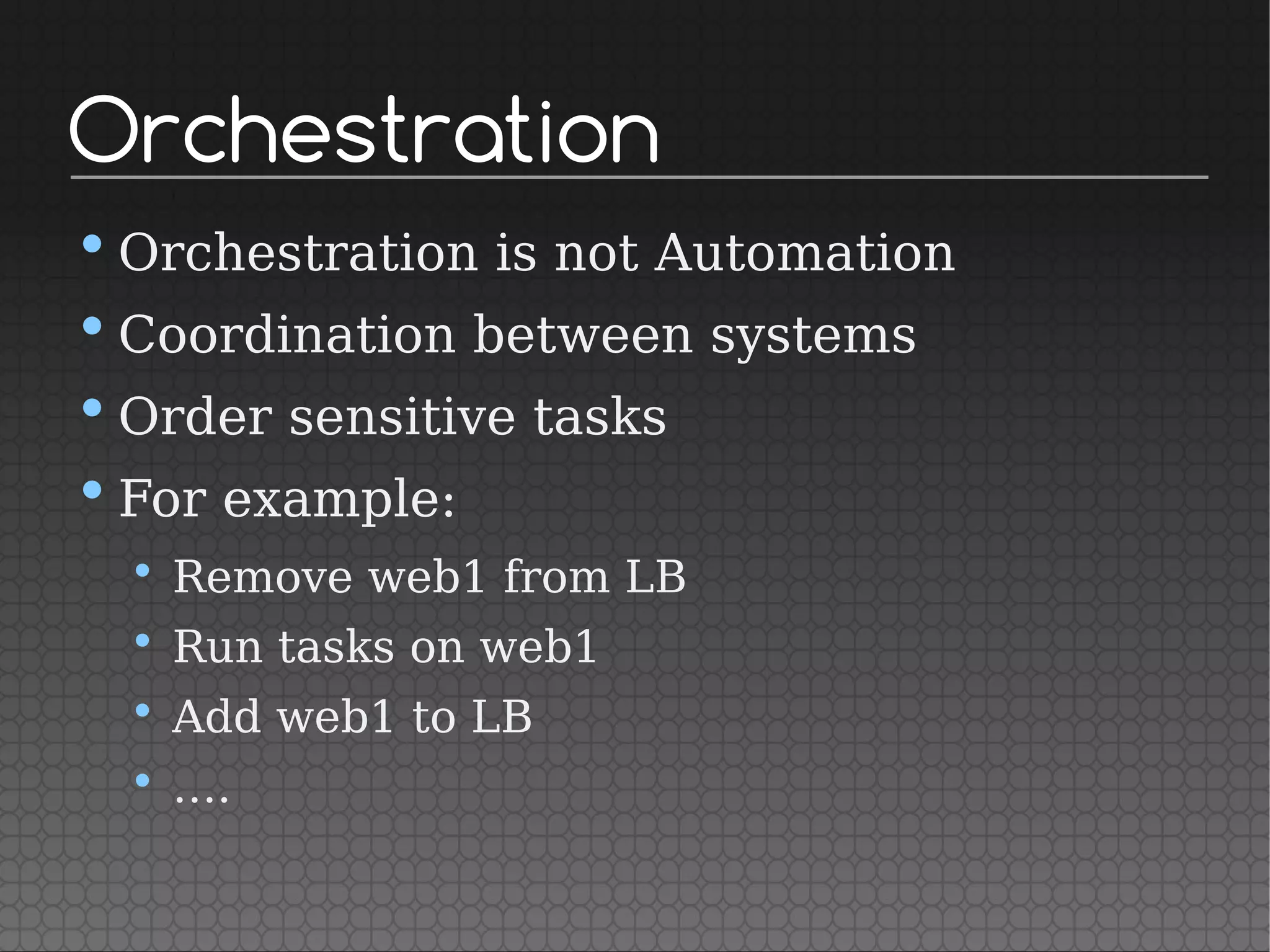
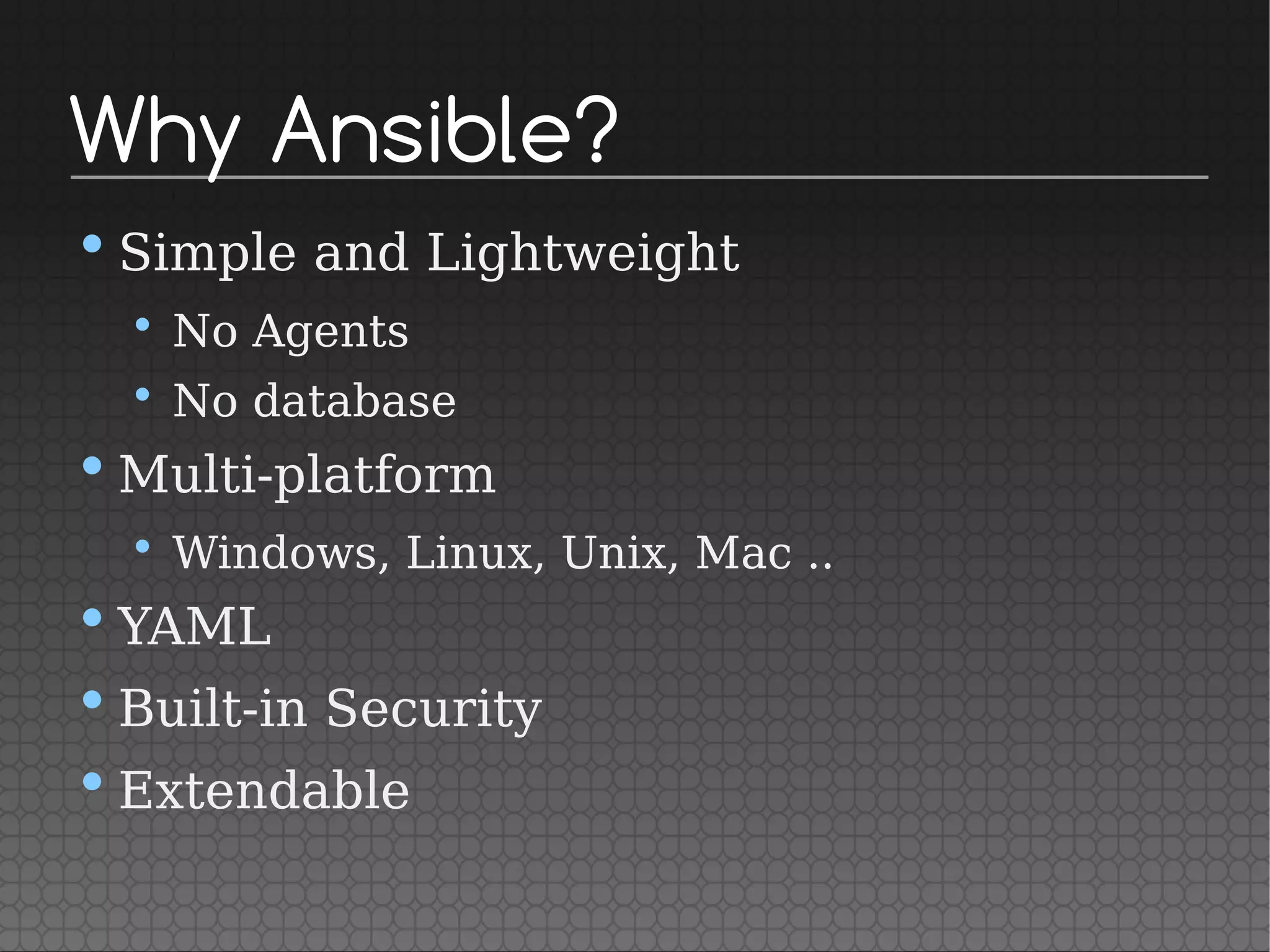
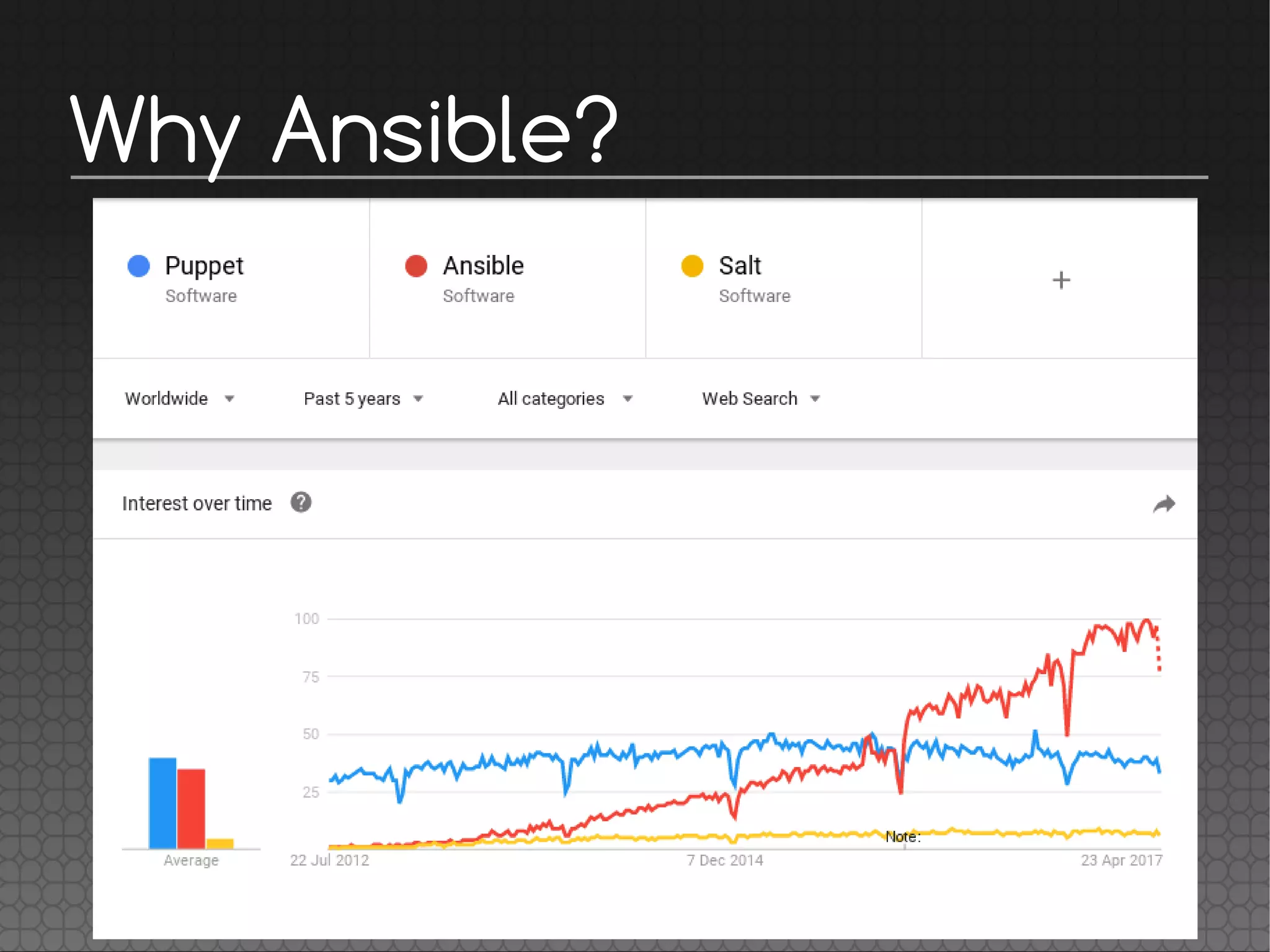

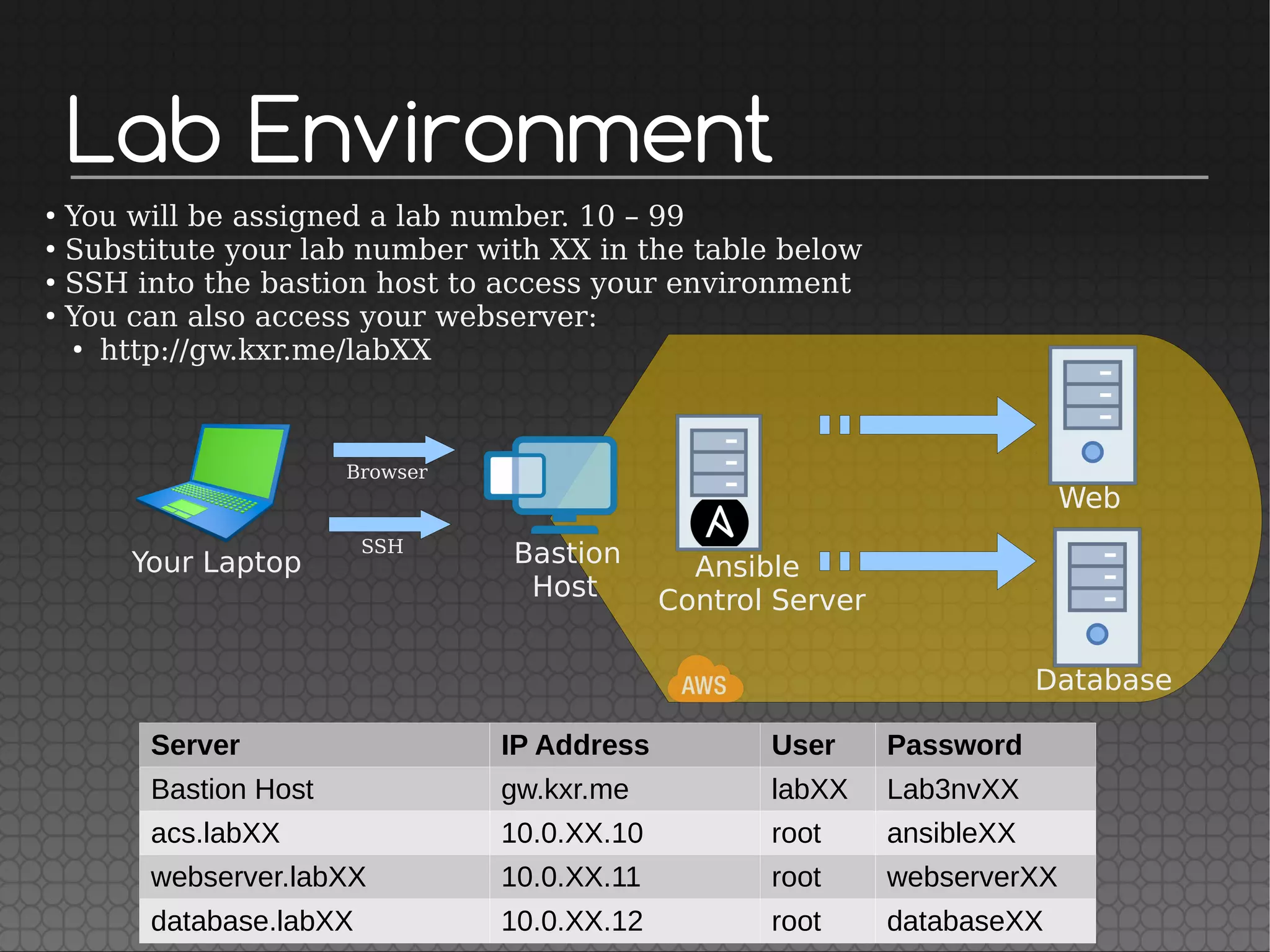
![Setup your laptop
• Your laptop should be connected to the internet
• Use your favorite SSH client on you laptop (e.g. Putty)
• Create 3 separate connections to the bastion host for
each node: acs, webserver, database
• Each node is having a basic installation of CentOS 7
• Make sure you are on the correct nodes
• The color of the prompt should help you identify each
node:
[root@acs ~]
[root@webserver ~]
[root@database ~]](https://image.slidesharecdn.com/automationwithansible-170723054153/75/Automation-with-ansible-14-2048.jpg)
![Installing Ansible
On the Control Server [root@acs ~]
yum -y update
yum -y install epel-release
yum -y install ansible
• Ansible is installed (that simple!)
• Ansible Configuration: /etc/ansible/ansible.cfg
• Default inventory: /etc/ansible/host
• Easily refer to the documentation:
ansible-doc -l
ansible-doc <module>
ansible-doc -s <module>](https://image.slidesharecdn.com/automationwithansible-170723054153/75/Automation-with-ansible-15-2048.jpg)

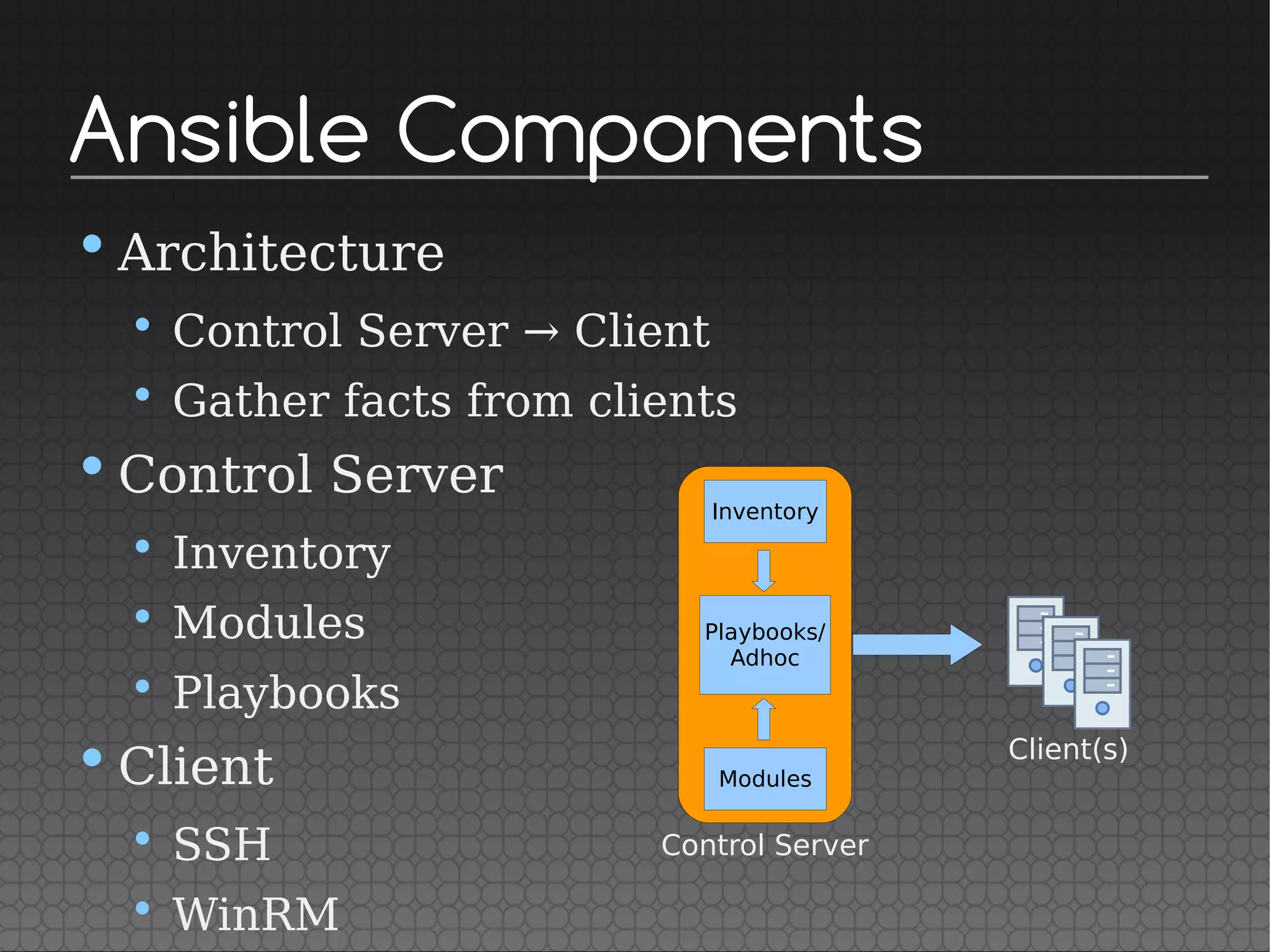
![Inventory
• Default: /etc/ansible/hosts
• Custom inventory using -i switch
• Use custom inventories to isolate environments e.g.
Prod, dev, US
• Hosts, Groups, Variables
• Default Groups: all, ungrouped
• For example: mail.example.com
[webservers]
one.example.com
alpha.example.com ansible_host=192.0.2.50
[dbservers]
one.example.com
two.example.com
three.example.com ansible_host=192.0.2.99](https://image.slidesharecdn.com/automationwithansible-170723054153/75/Automation-with-ansible-18-2048.jpg)
![Setup inventory
• /etc/ansible/hosts
• Make sure the hostnames are reachable
yum -y install nano vim emacs
cd /etc/ansible
<editor> hosts
[app]
webserver.labXX
database.labXX
[webservers]
webserver.labXX
[dbservers]
database.labXX](https://image.slidesharecdn.com/automationwithansible-170723054153/75/Automation-with-ansible-19-2048.jpg)
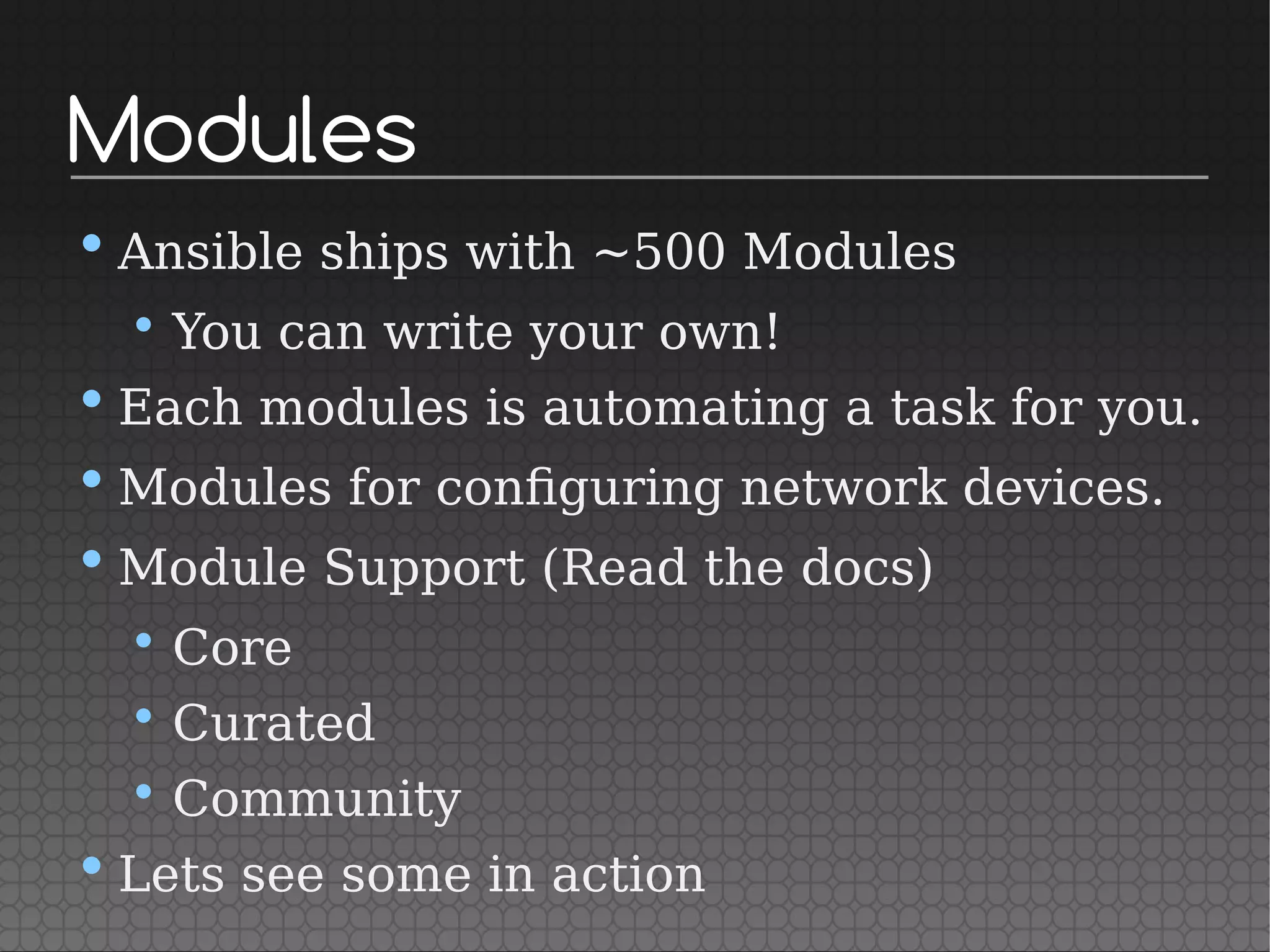
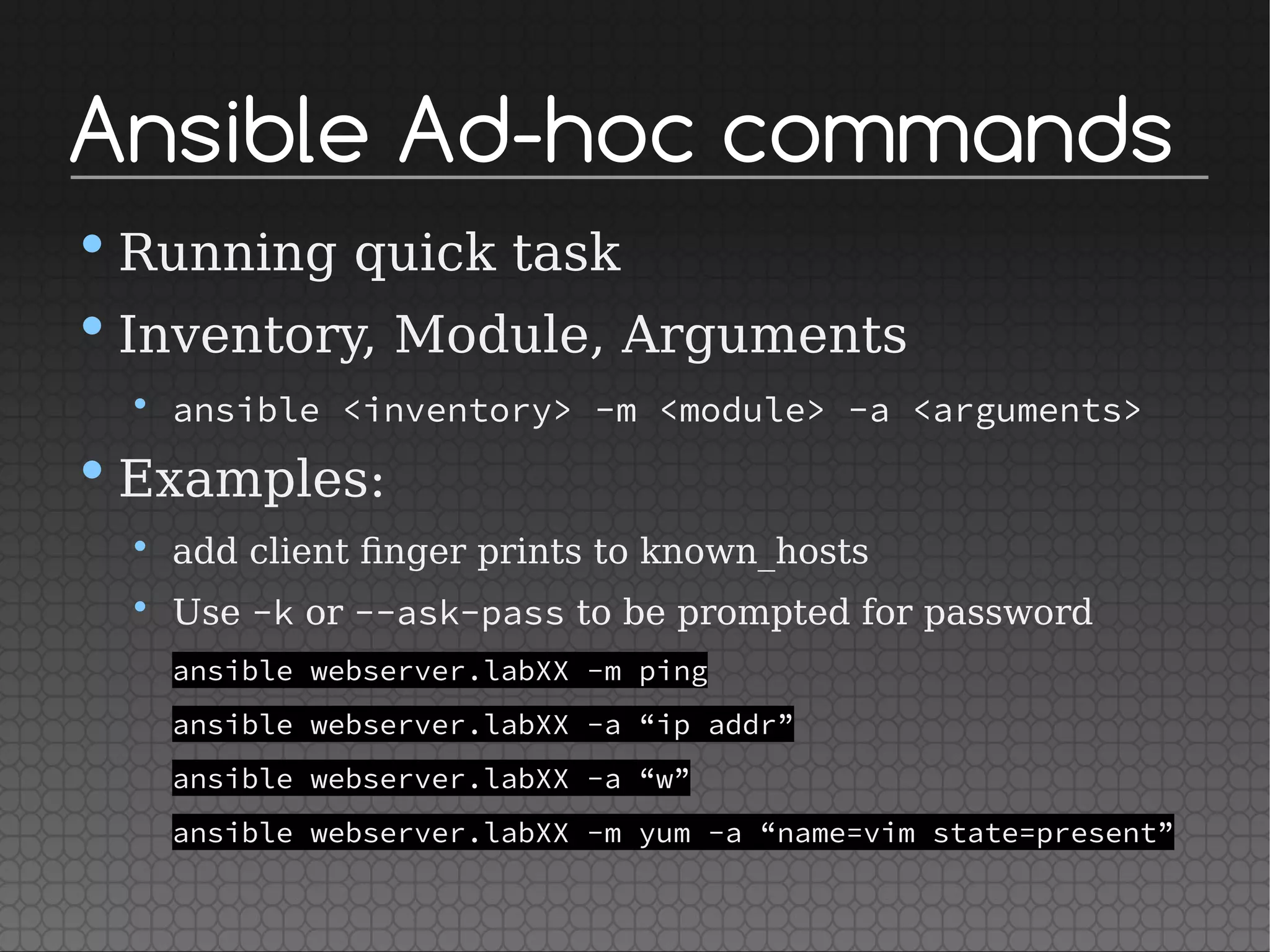
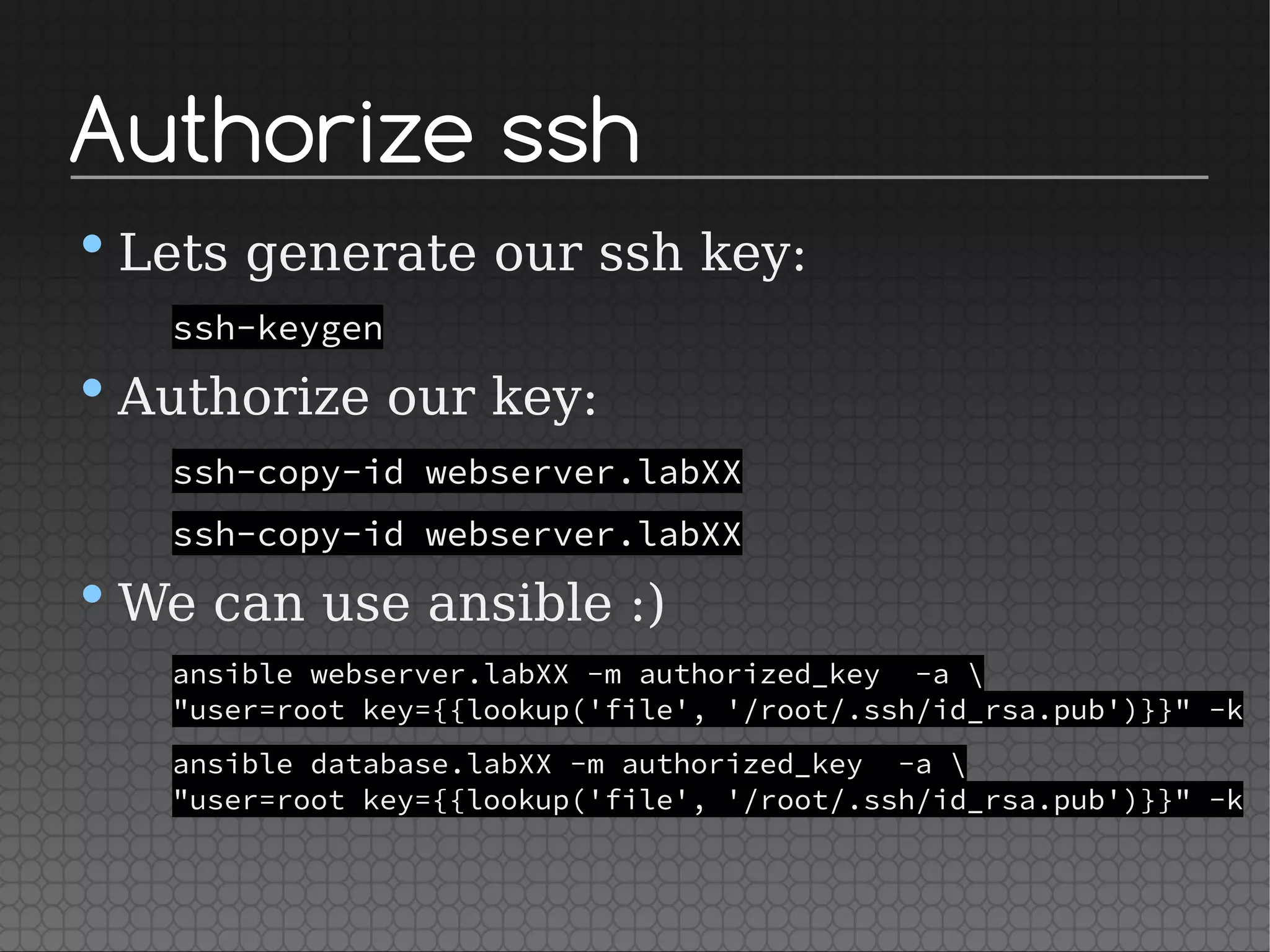
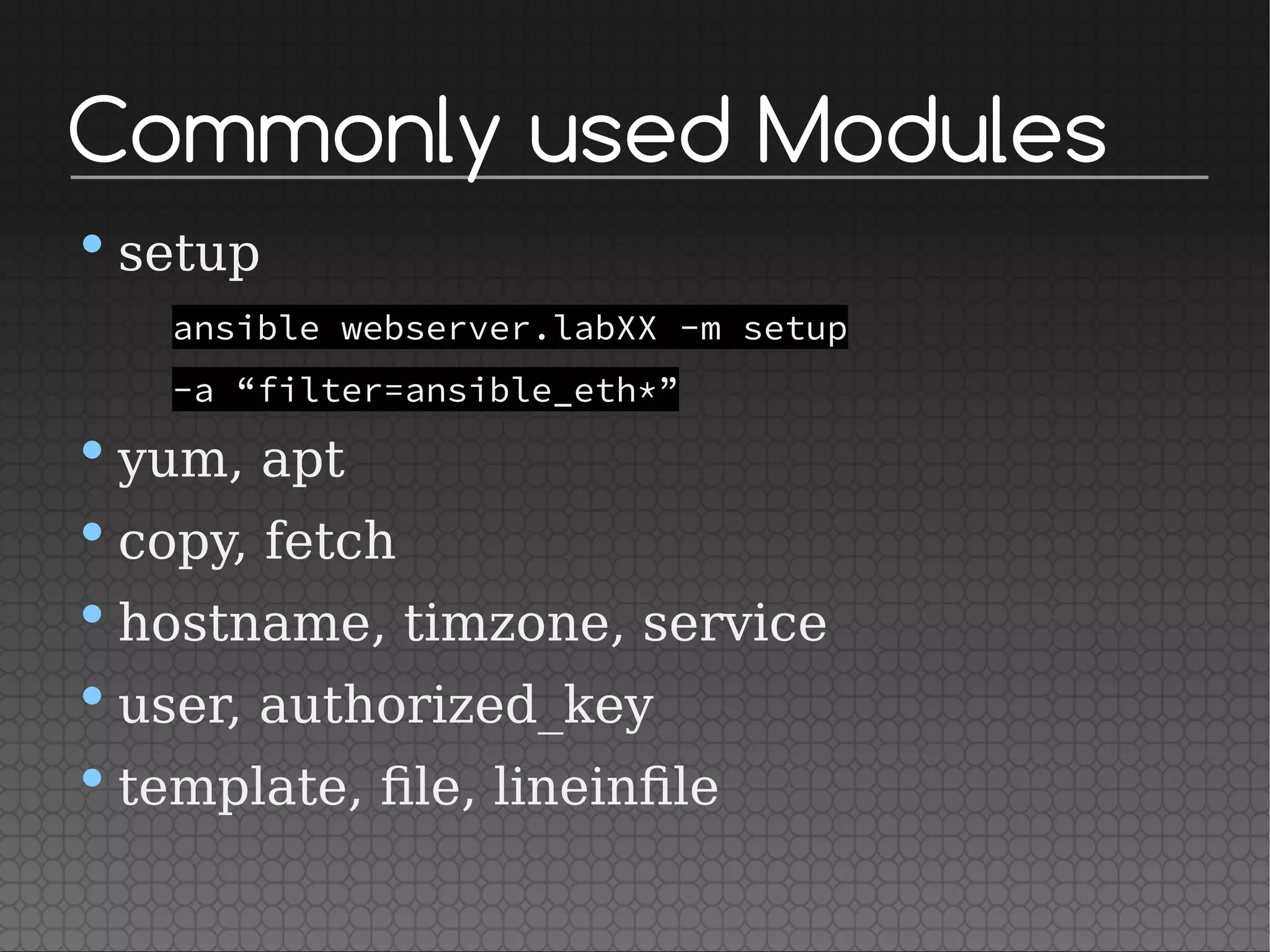
![Targeting hosts and groups
•OR group1:group2
ansible webservers:dbservers -m ping
•AND group1:&group2
ansible ‘app:&dbservers’ -m ping
•NOT !group1
ansible ‘app:!dbservers’ -m ping
•Combination group1:&group2:!group3
•Wildcard and Regex
ansible *.lab* -m ping
~web[0-9]+](https://image.slidesharecdn.com/automationwithansible-170723054153/75/Automation-with-ansible-24-2048.jpg)
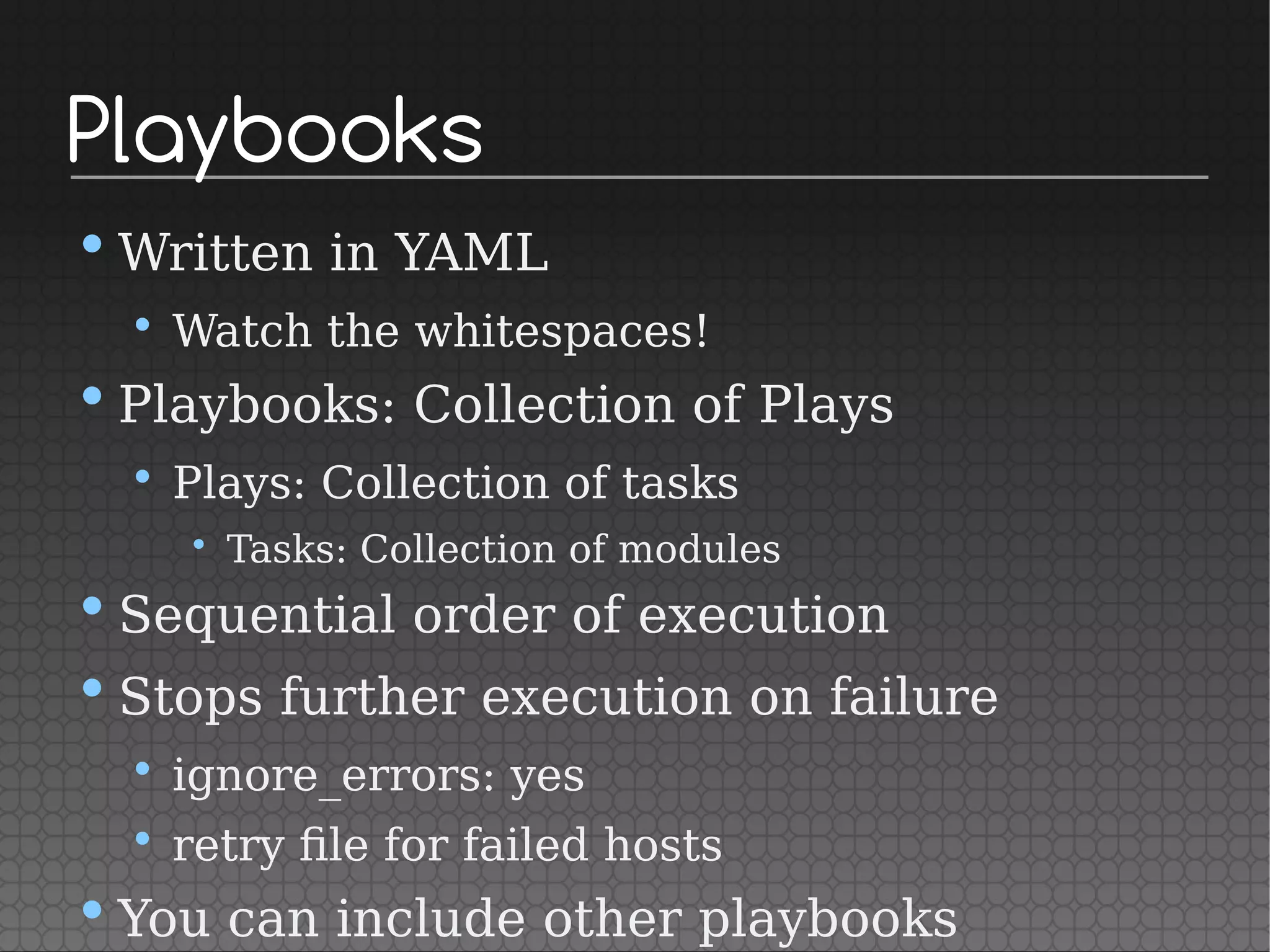
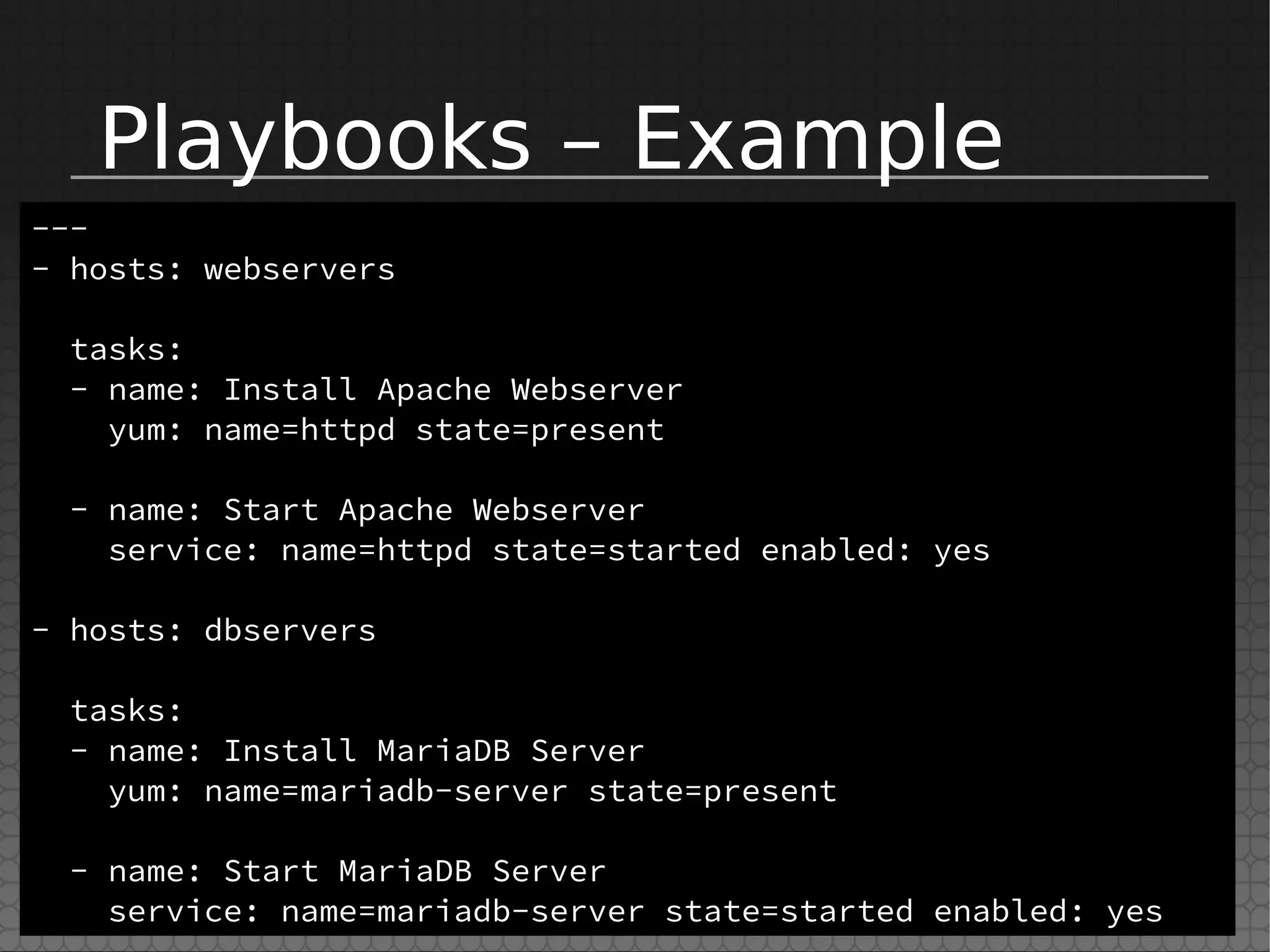
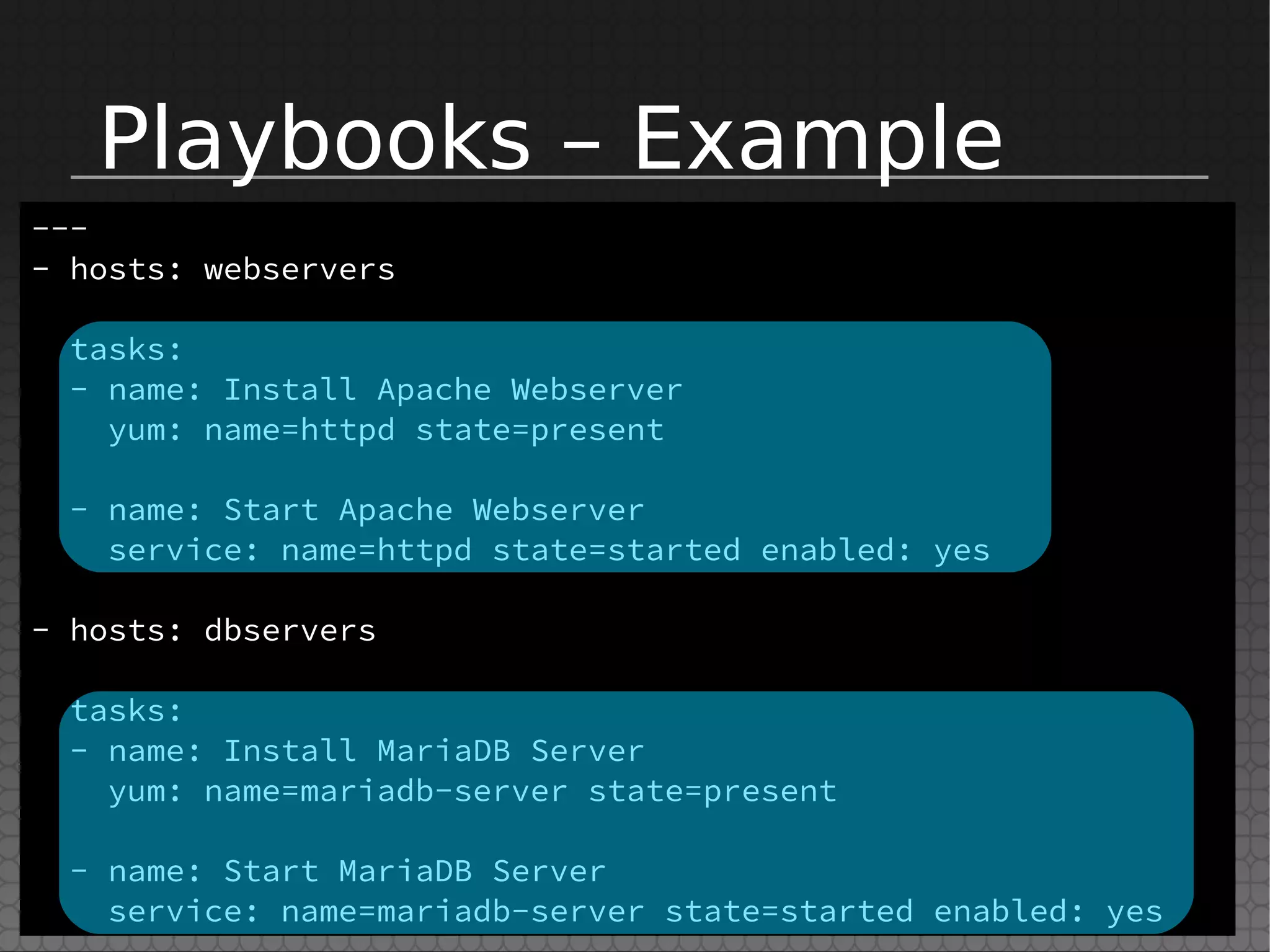
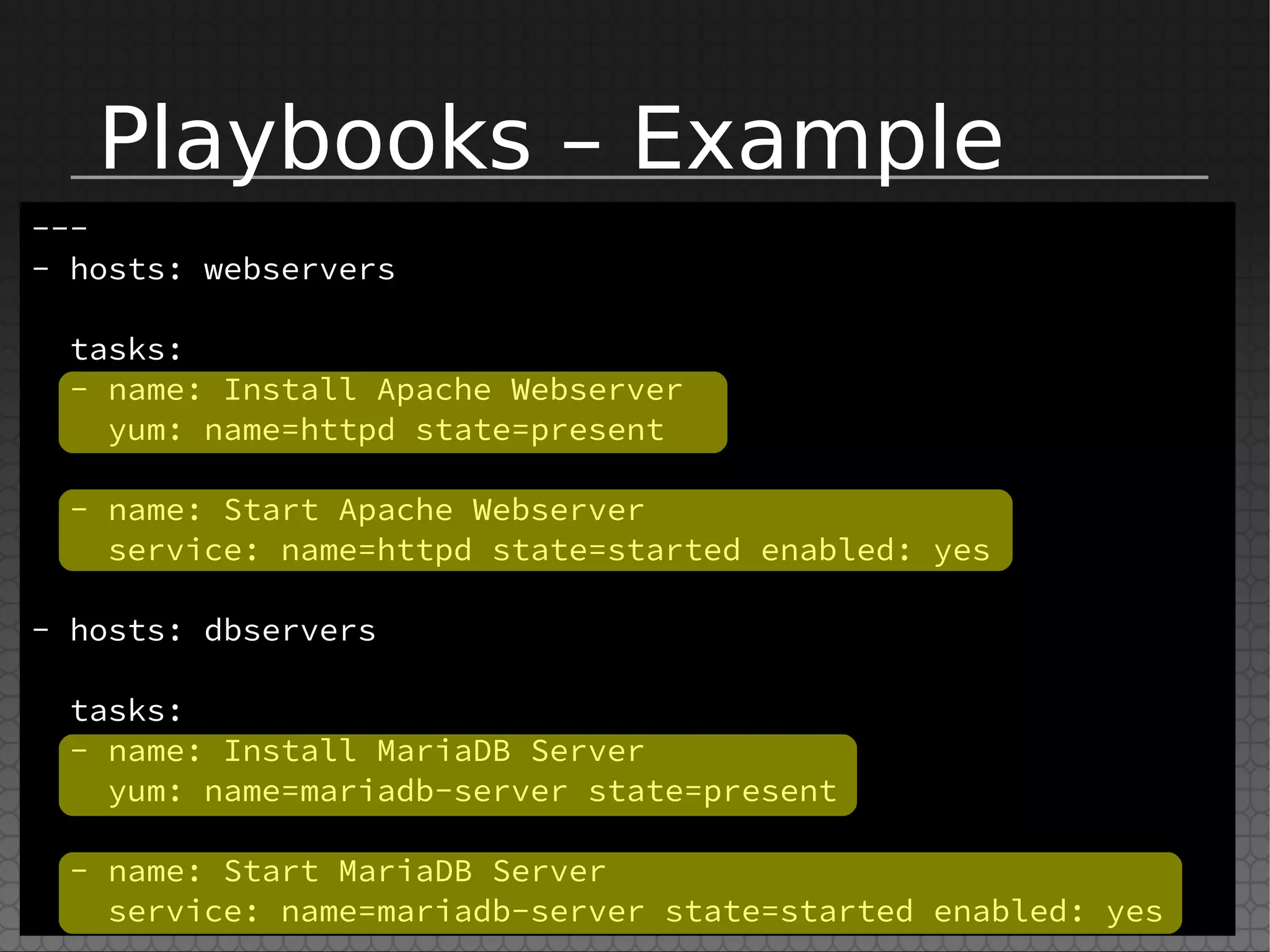
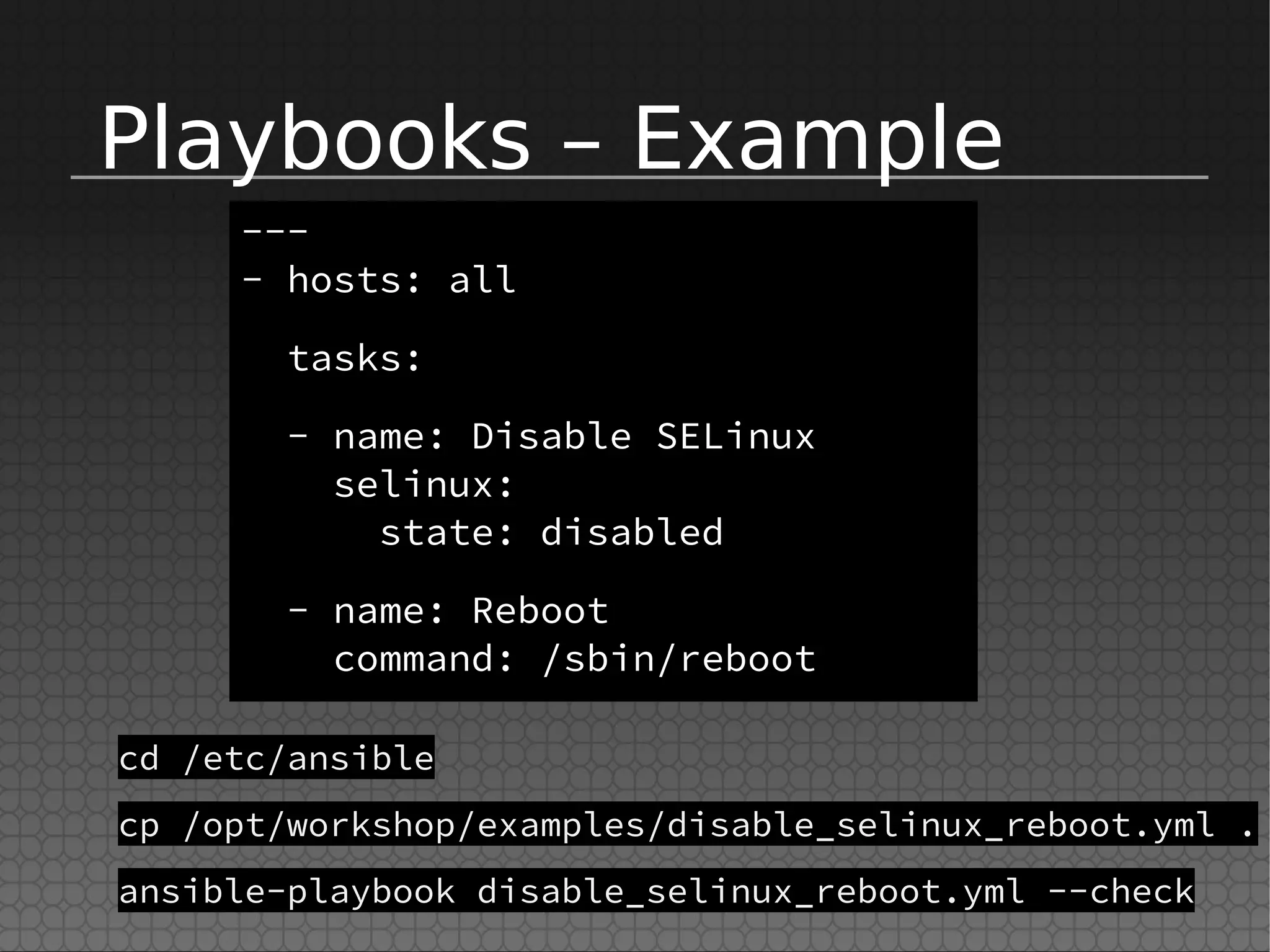

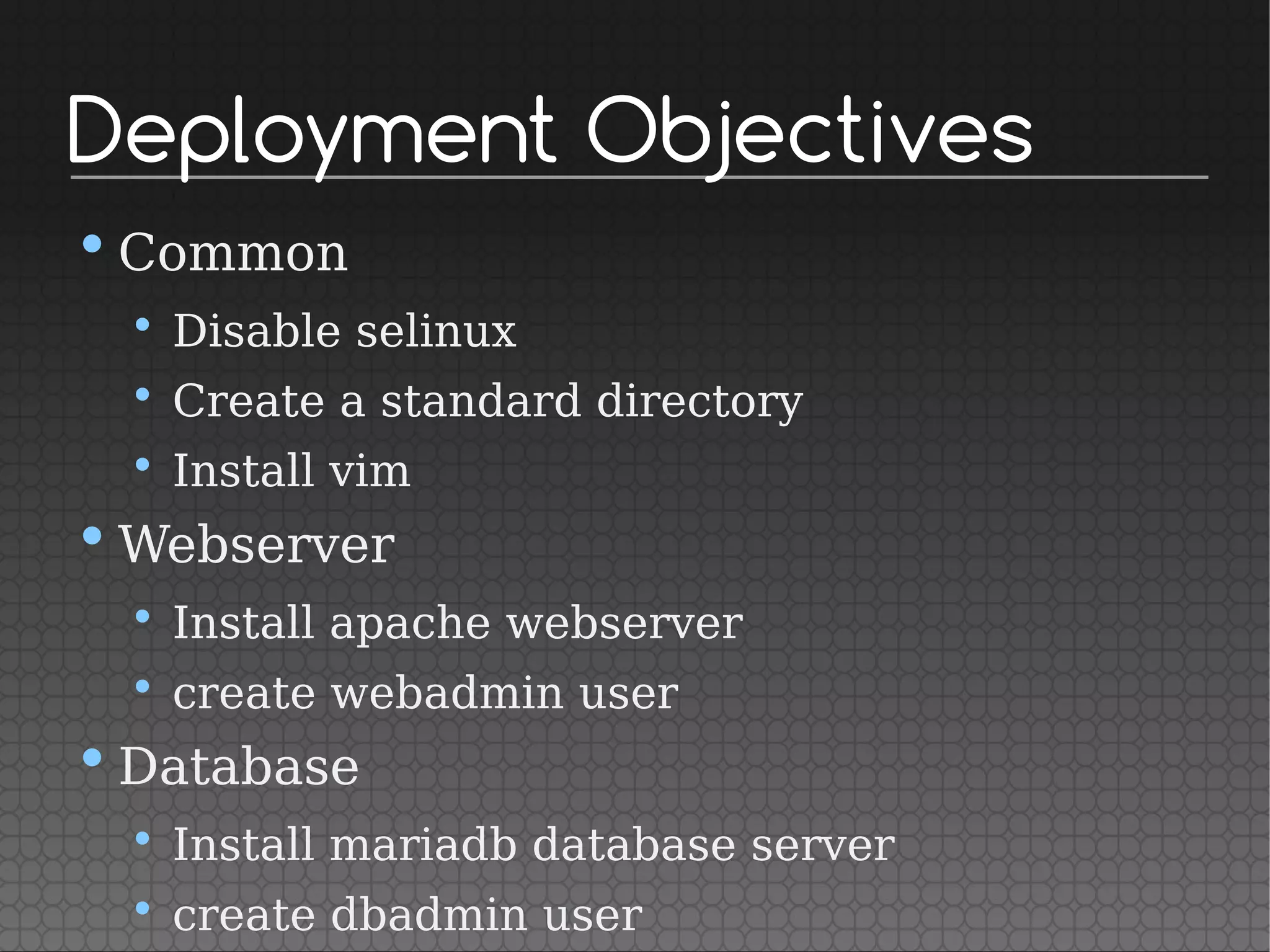
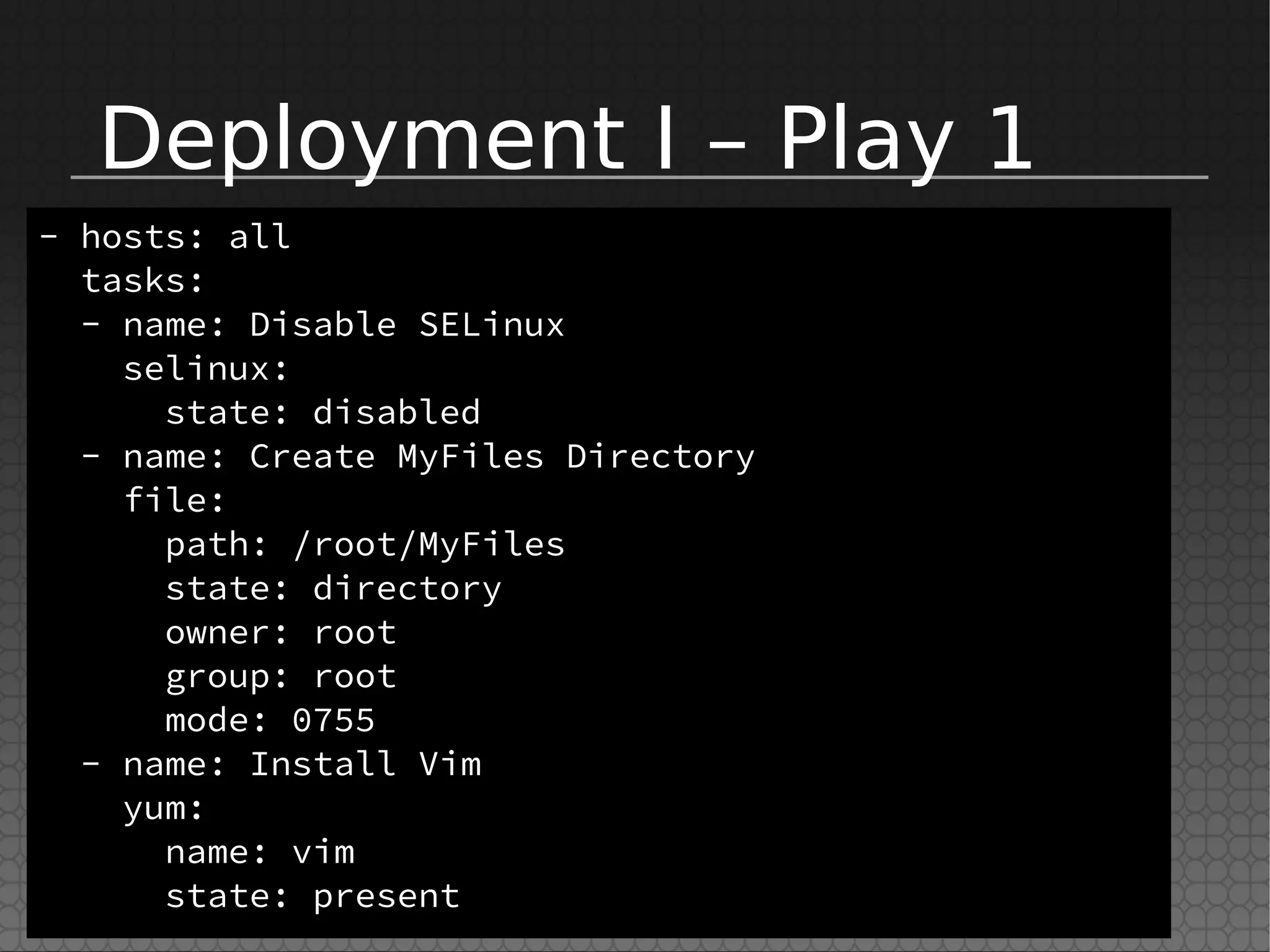
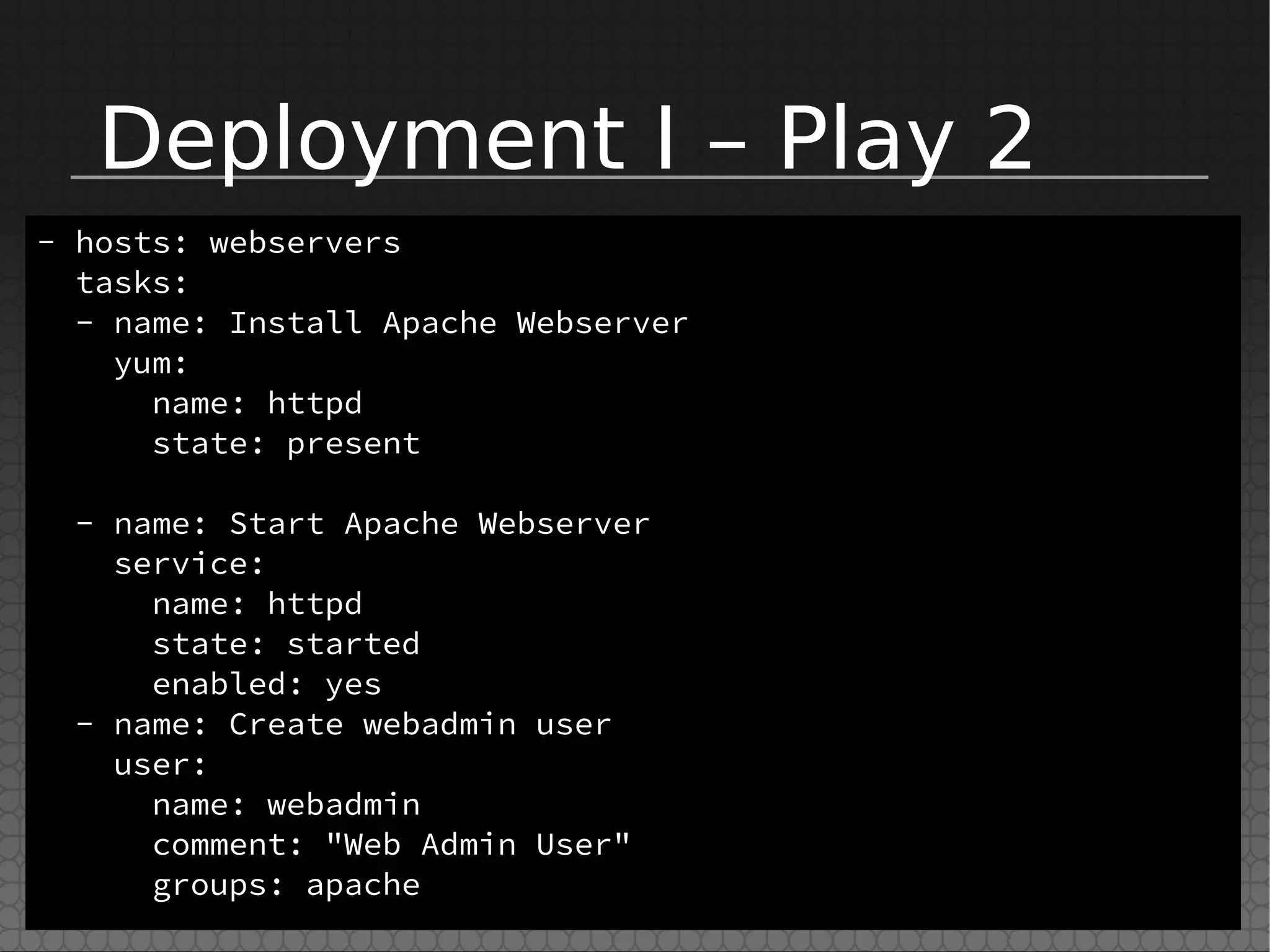
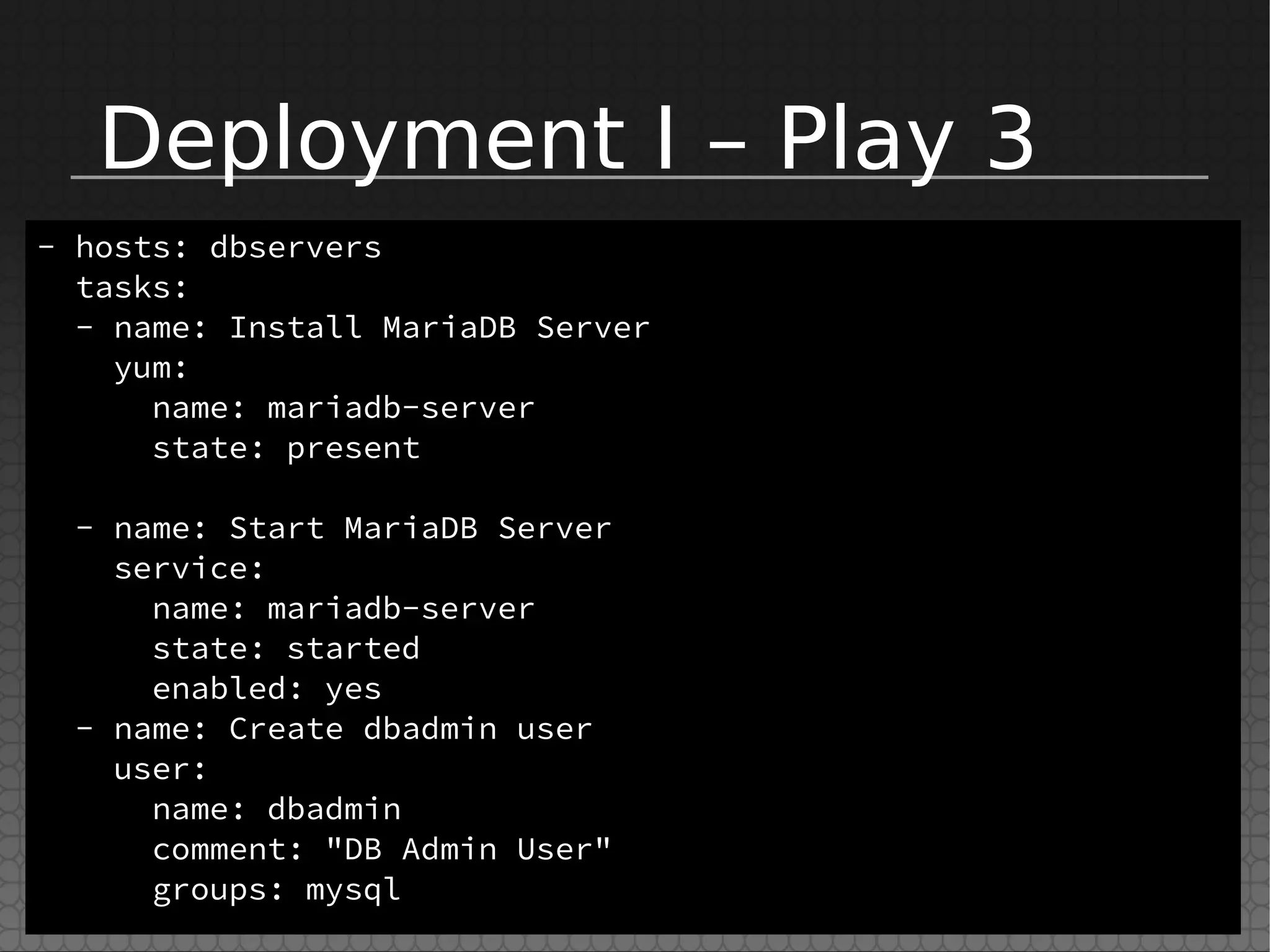
![Deployment I
•Copy and run the playbook from
/opt/workshop/rwd1
[root@acs ~]
cd /etc/ansible
cp /opt/workshop/rwd1/playbook1.yml .
ansible-playbook playbook1.yml --check
ansible-playbook playbook1.yml
•Test services on both nodes
•Run the playbook again](https://image.slidesharecdn.com/automationwithansible-170723054153/75/Automation-with-ansible-35-2048.jpg)
![Playbook Output
PLAY [all] ******************************************************************
TASK [Gathering Facts] ******************************************************
ok: [webserver.lab10]
ok: [database.lab10]
TASK [Disable SELinux] ******************************************************
changed: [webserver.lab10]
changed: [database.lab10]
.. .. .. ..
PLAY [webservers] ***********************************************************
TASK [Gathering Facts] ******************************************************
ok: [webserver.lab10]
TASK [Install Apache Webserver] *********************************************
changed: [webserver.lab10]
.. .. .. ..
PLAY RECAP ******************************************************************
database.lab10 : ok=8 changed=6 unreachable=0 failed=0
webserver.lab10 : ok=8 changed=6 unreachable=0 failed=0](https://image.slidesharecdn.com/automationwithansible-170723054153/75/Automation-with-ansible-36-2048.jpg)
![[Break]
Questions?](https://image.slidesharecdn.com/automationwithansible-170723054153/75/Automation-with-ansible-37-2048.jpg)



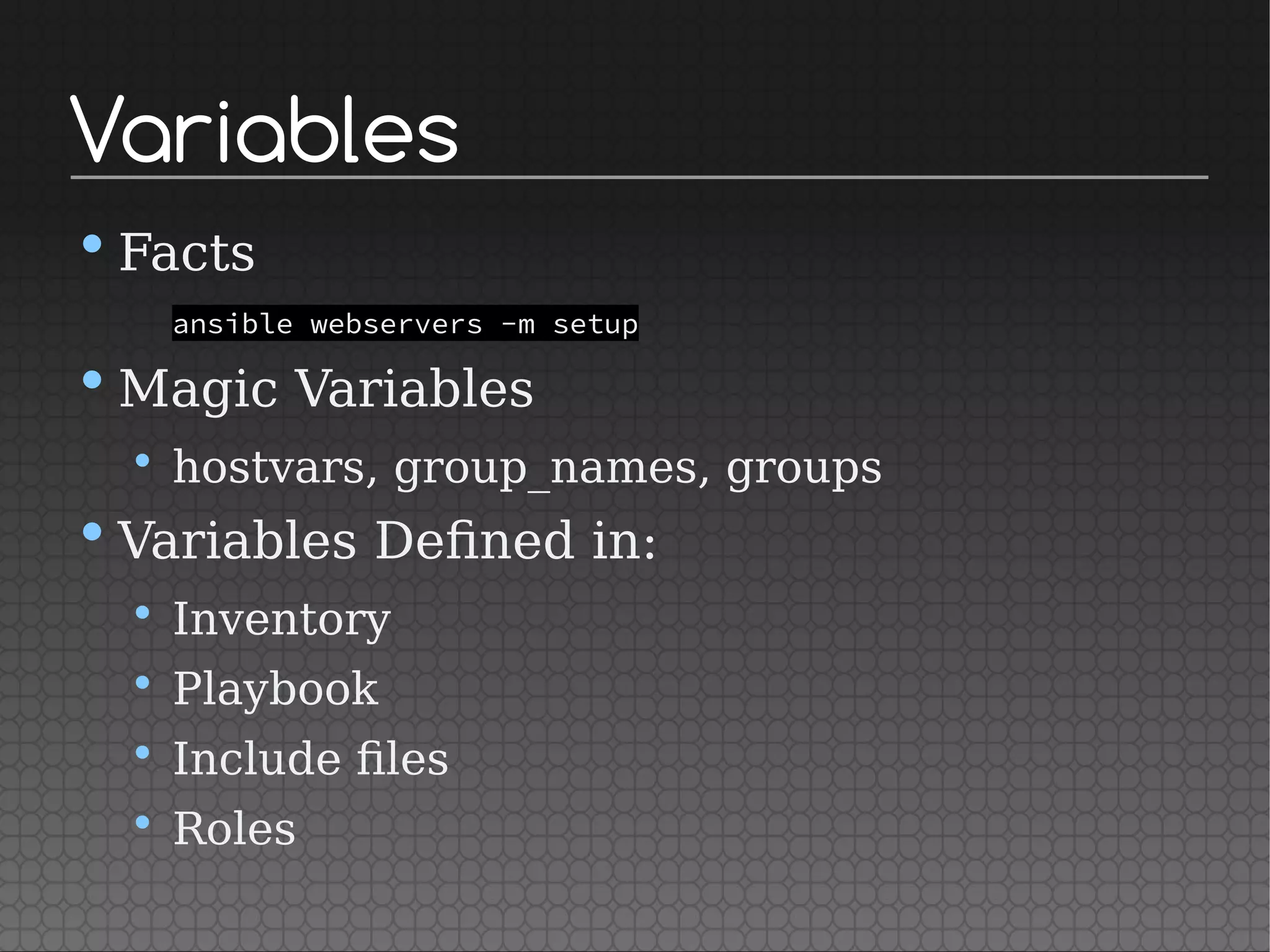
![Variables
• Variables in inventory
webserver.labXX ansible_port=2992 ansible_host=1.2.3.4
webserver.labXX http_port=80 maxRequestsPerChild=100
• Inventory variables in files:
• /etc/ansible/host_vars/webserver.labXX.yml
• /etc/ansible/group_vars/app.yml
[app]
webserver.labXX
database.labXX
[webservers]
webserver.labXX
[dbservers]
database.labXX
...
...
[app:vars]
ntp_server=1.2.3.4
[webservers:vars]
http_port=80
htdocs=/var/www/html
[dbservers:vars]
mariadb_port=3306
db_user = dbadmin](https://image.slidesharecdn.com/automationwithansible-170723054153/75/Automation-with-ansible-42-2048.jpg)
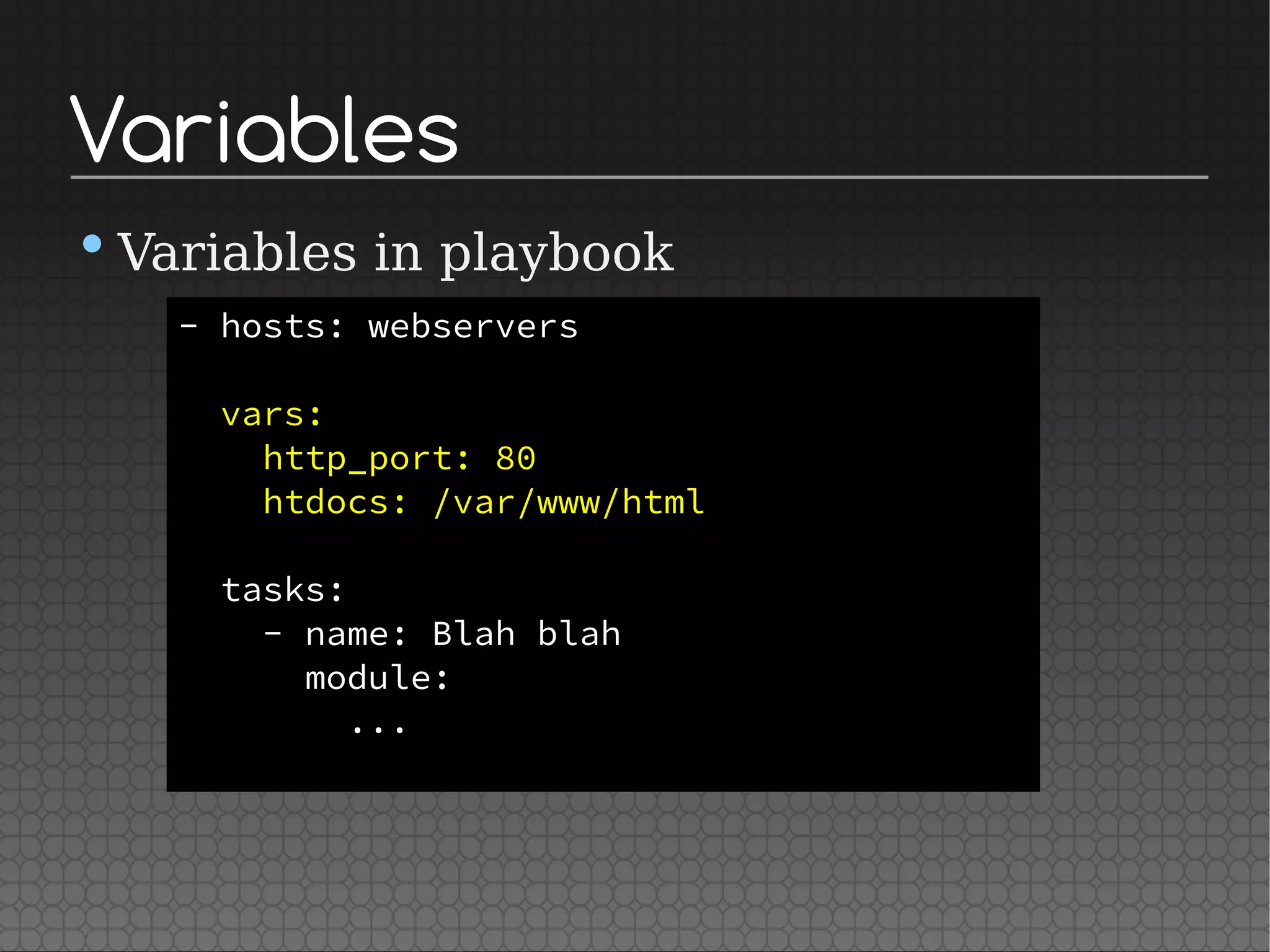
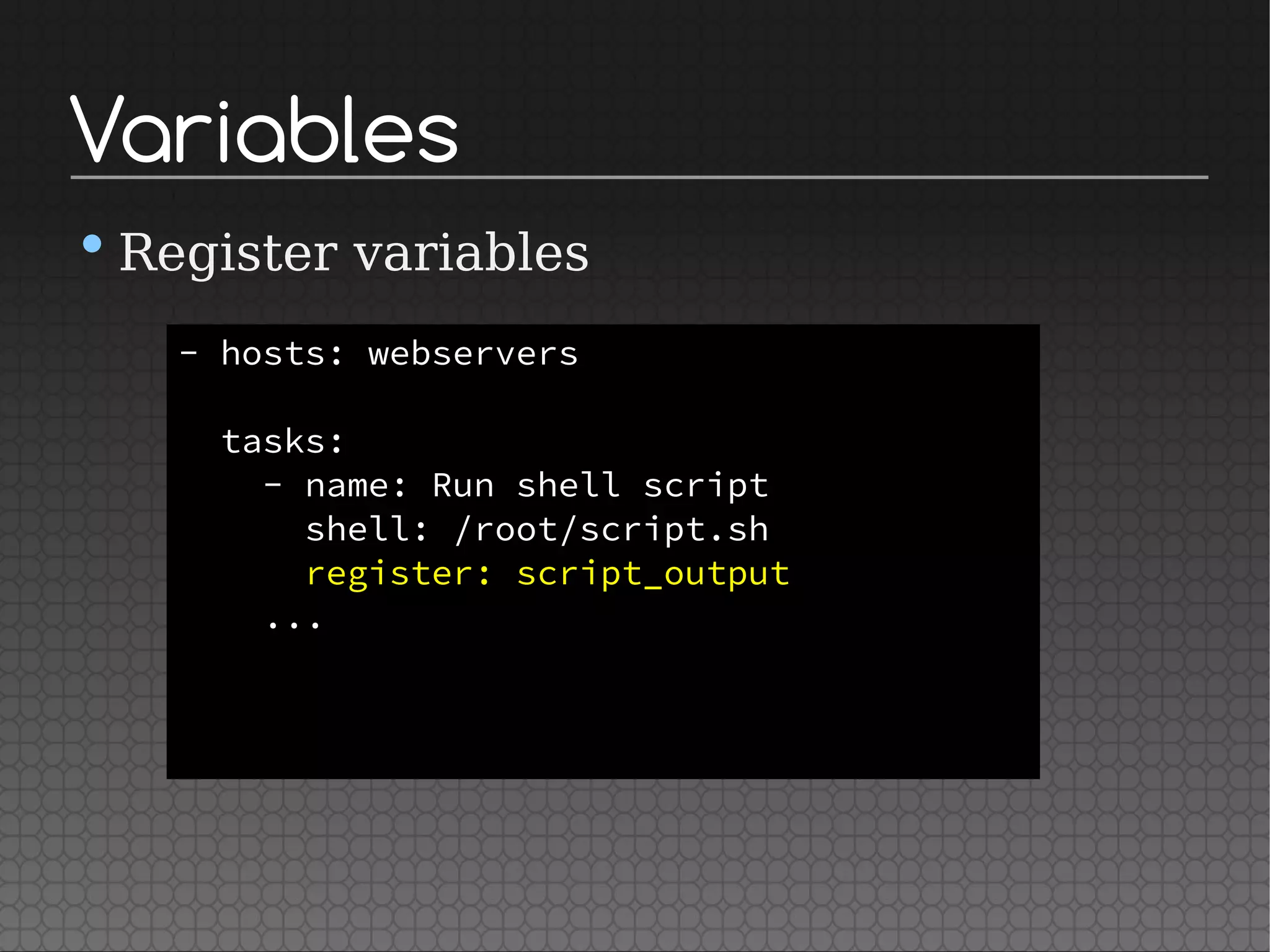
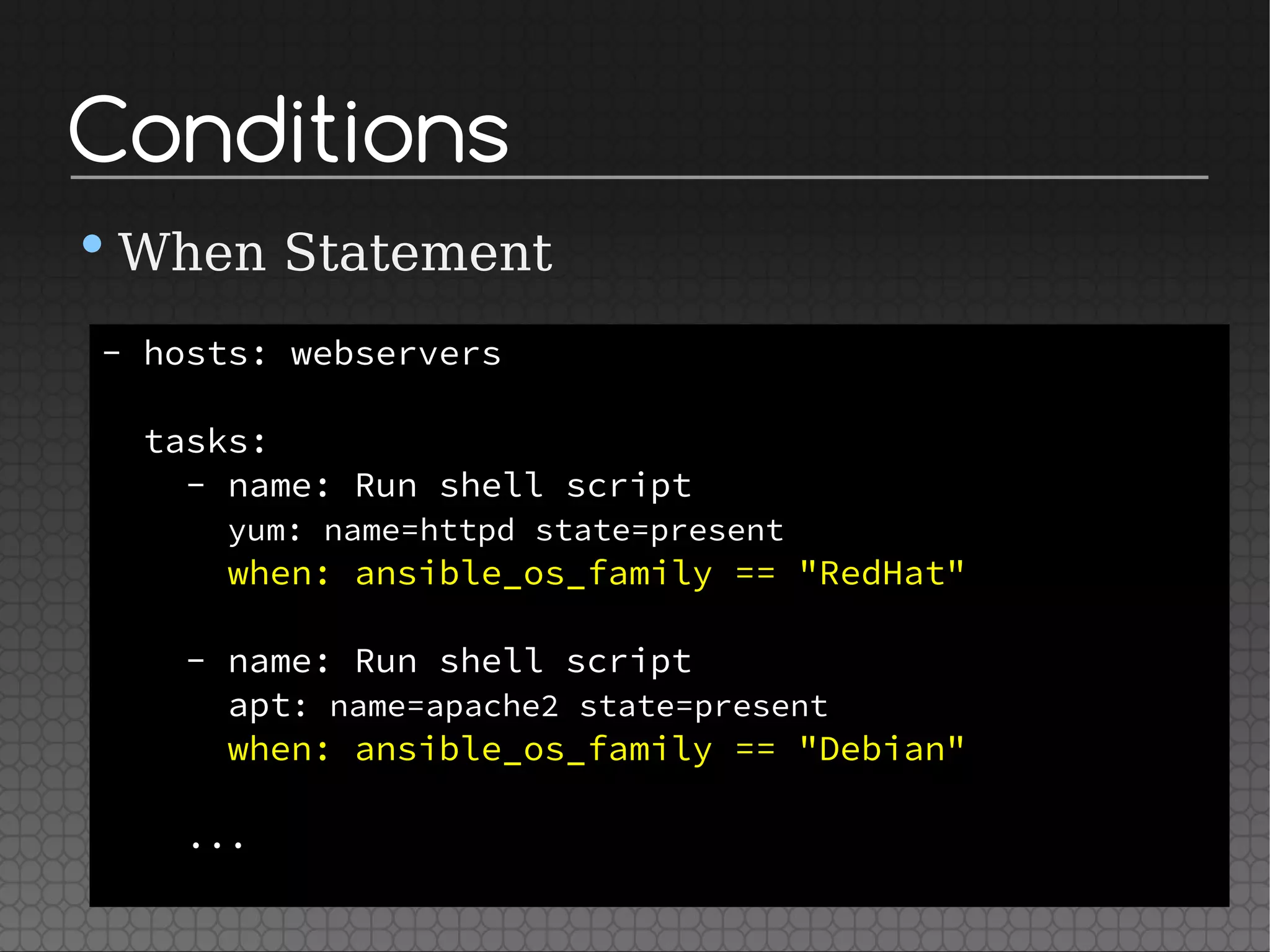
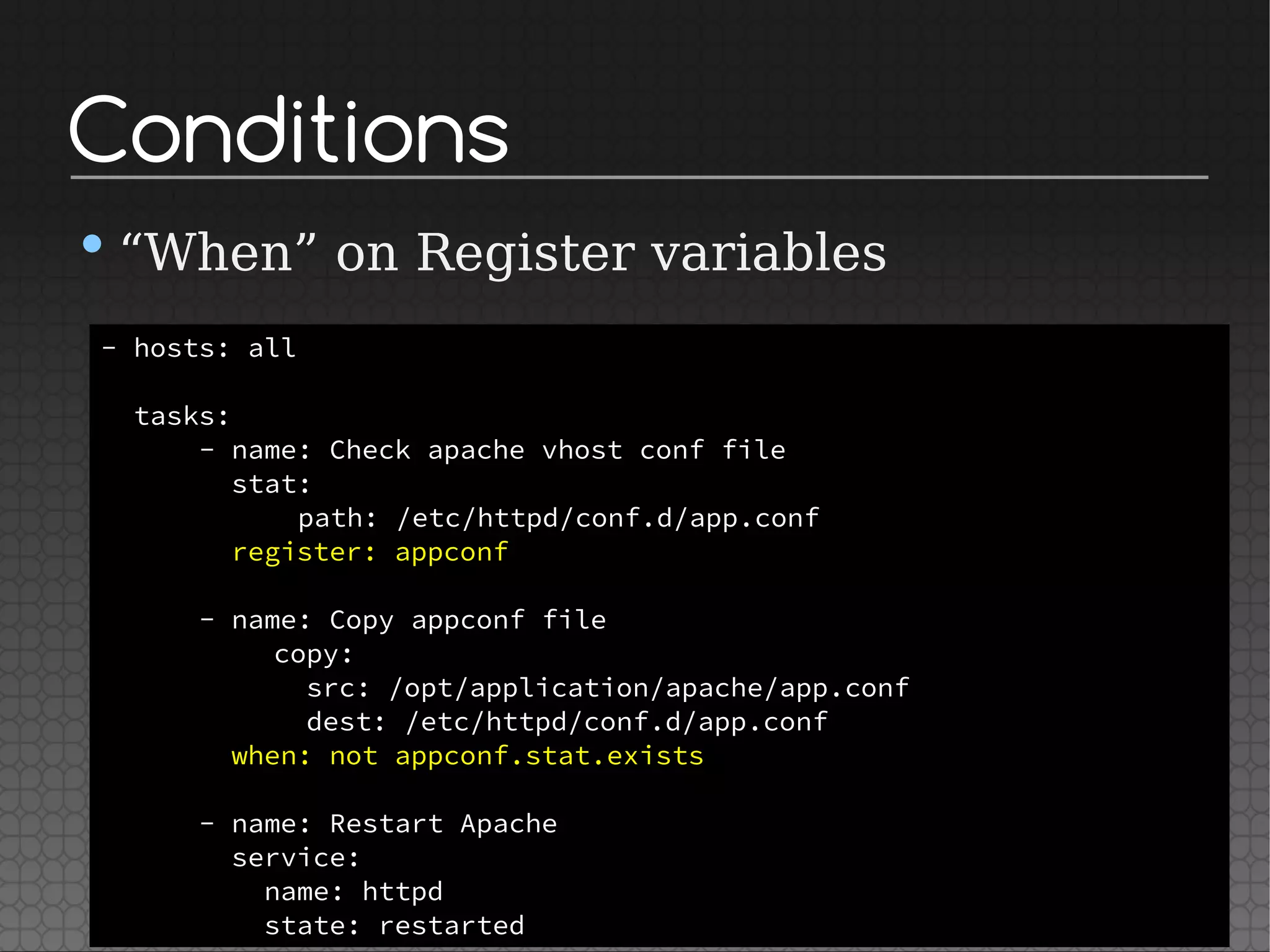
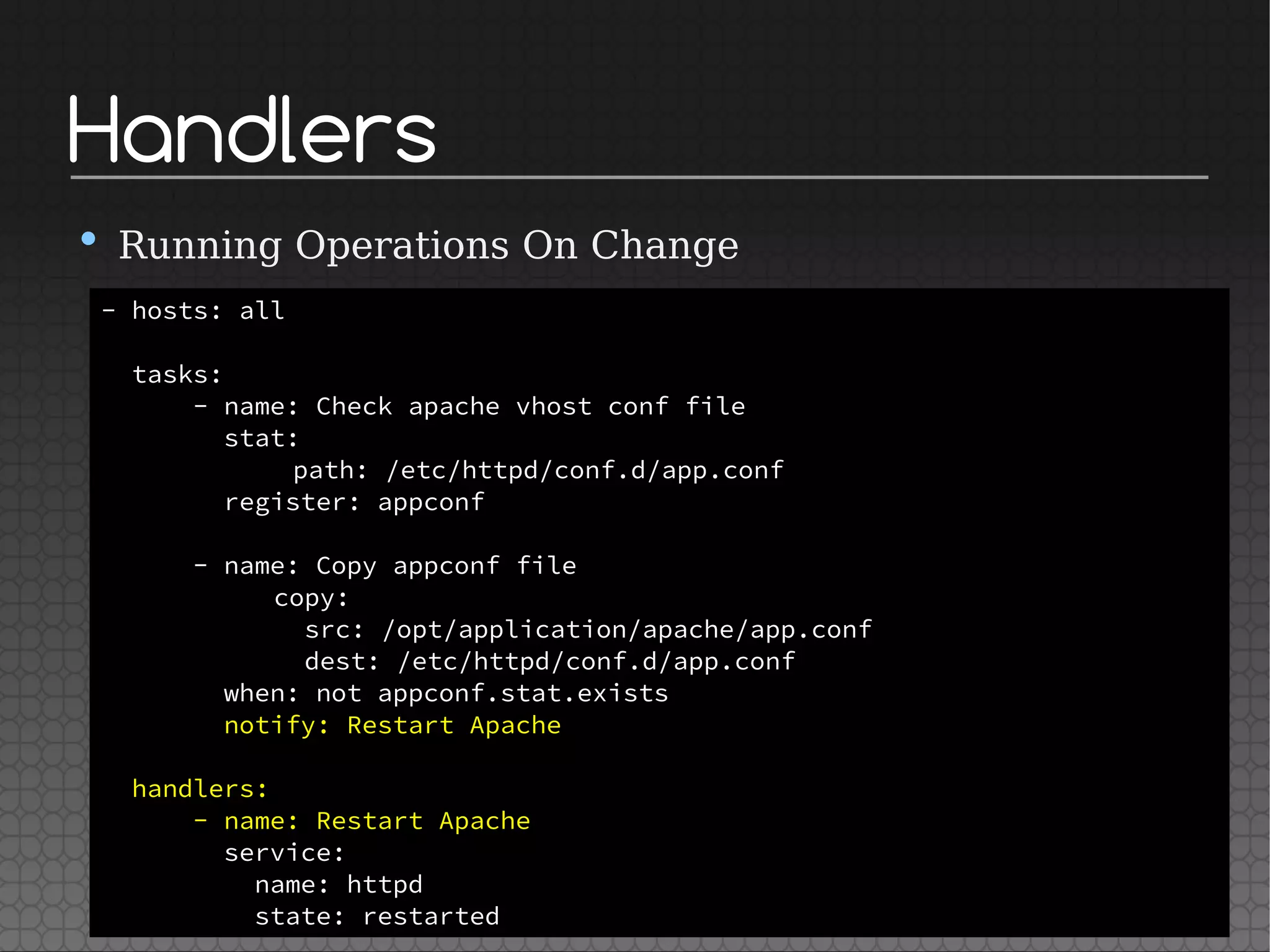
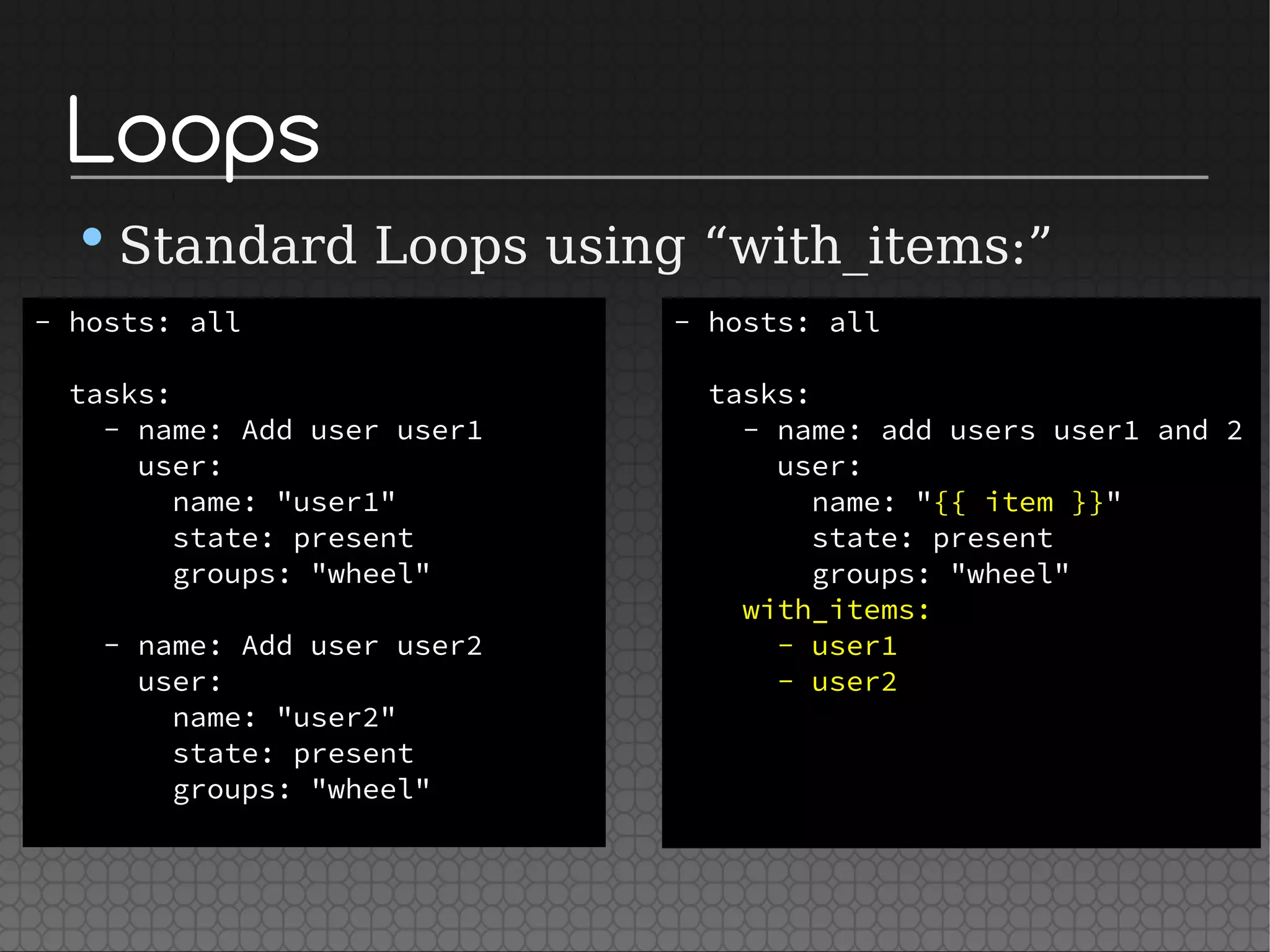
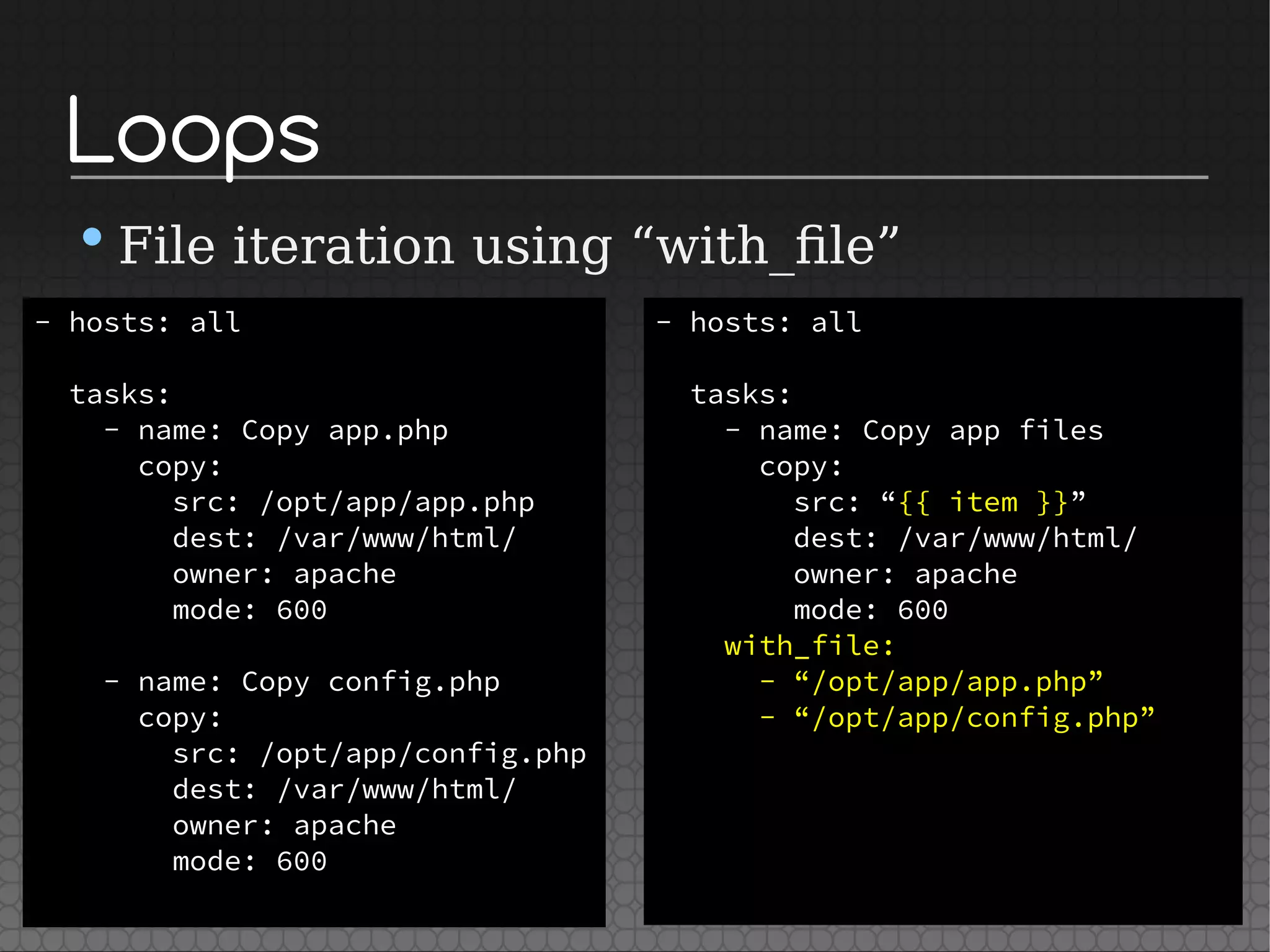
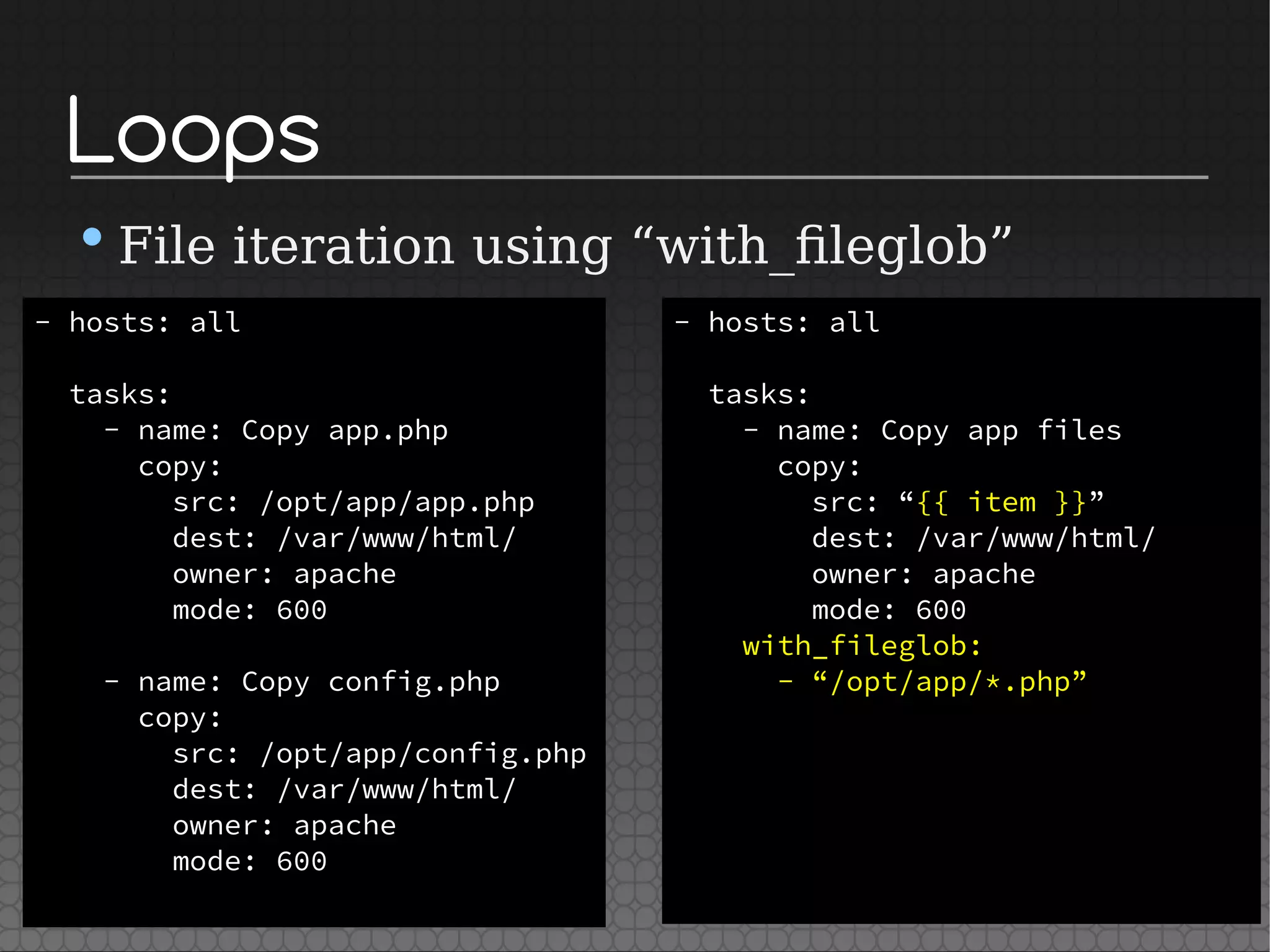
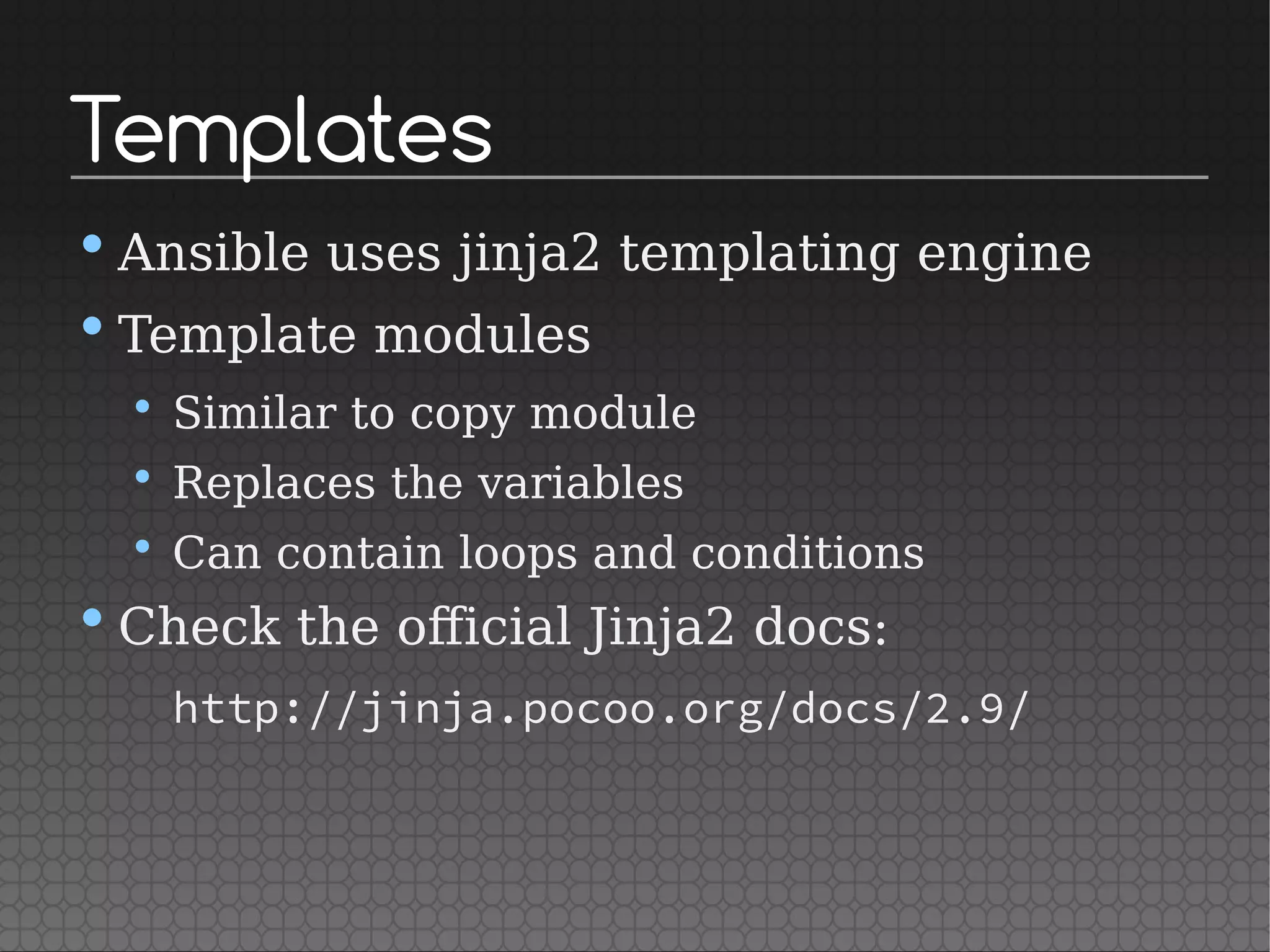
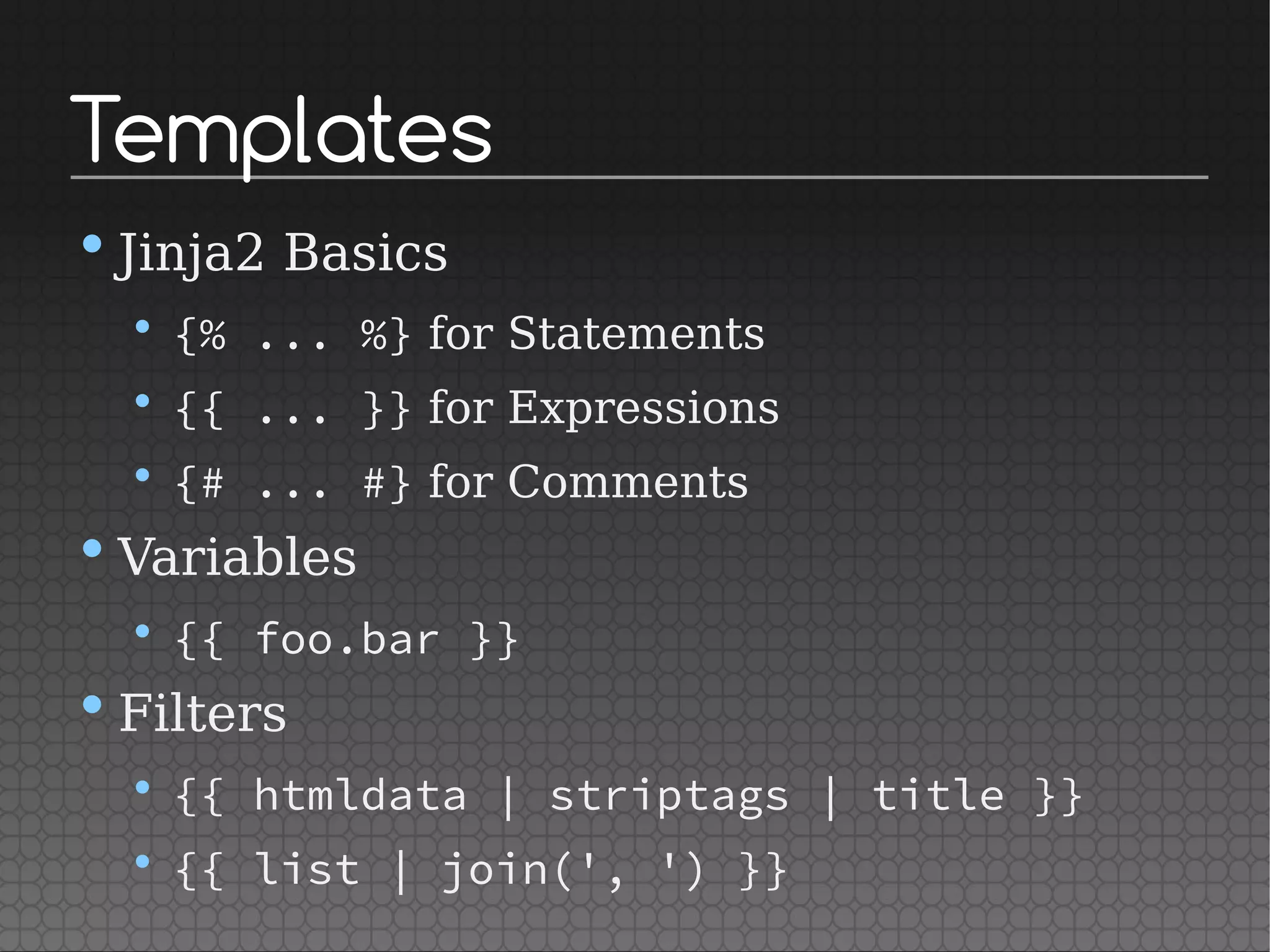
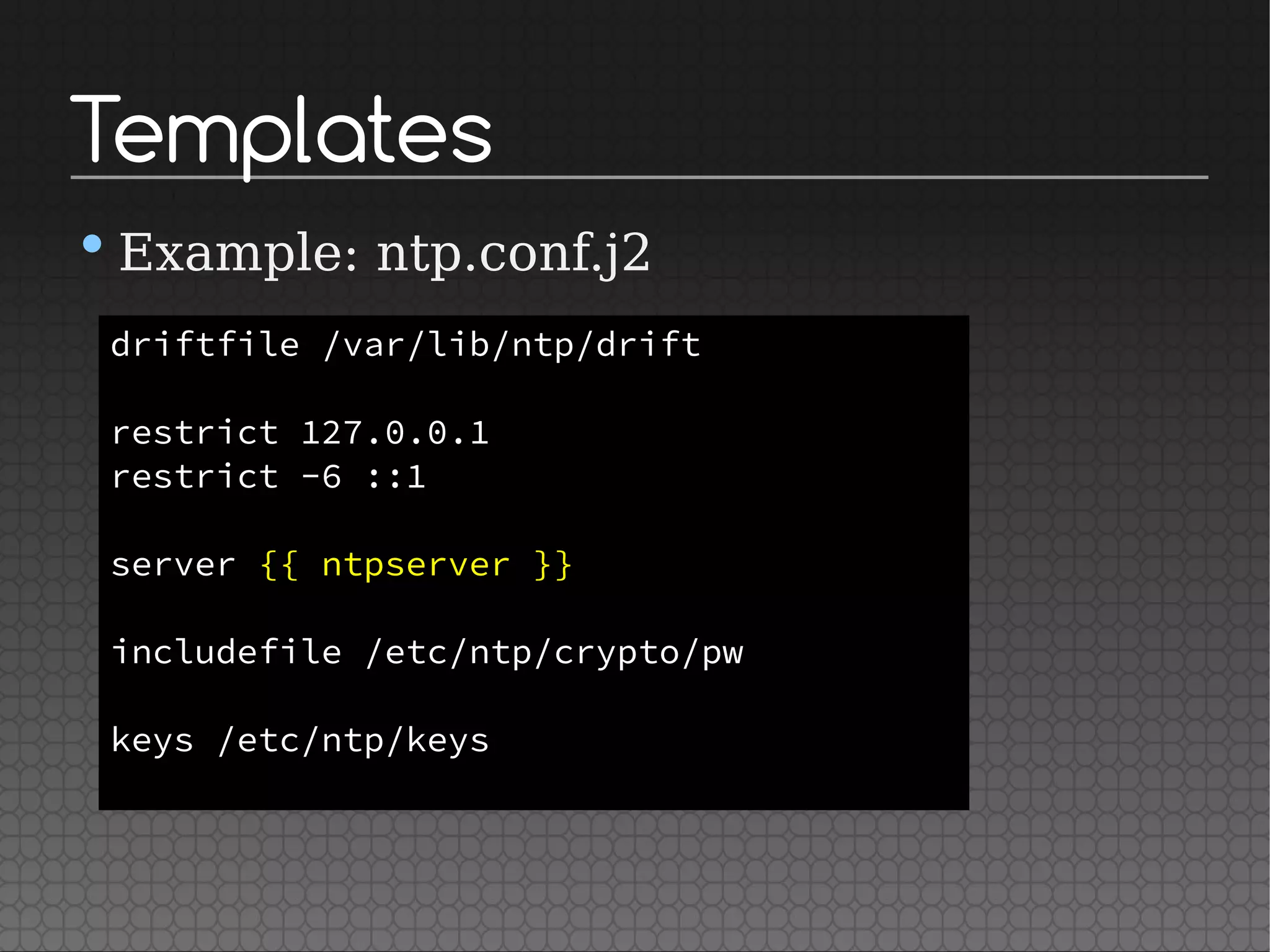
![Templates
•Example: my.cnf.j2
[mysqld]
datadir=/var/lib/mysql
socket=/var/lib/mysql/mysql.sock
user=mysql
# Disabling symbolic-links is recommended to
prevent assorted security risks
symbolic-links=0
port={{ mysql_port }}
[mysqld_safe]
log-error=/var/log/mysqld.log
pid-file=/var/run/mysqld/mysqld.pid](https://image.slidesharecdn.com/automationwithansible-170723054153/75/Automation-with-ansible-54-2048.jpg)
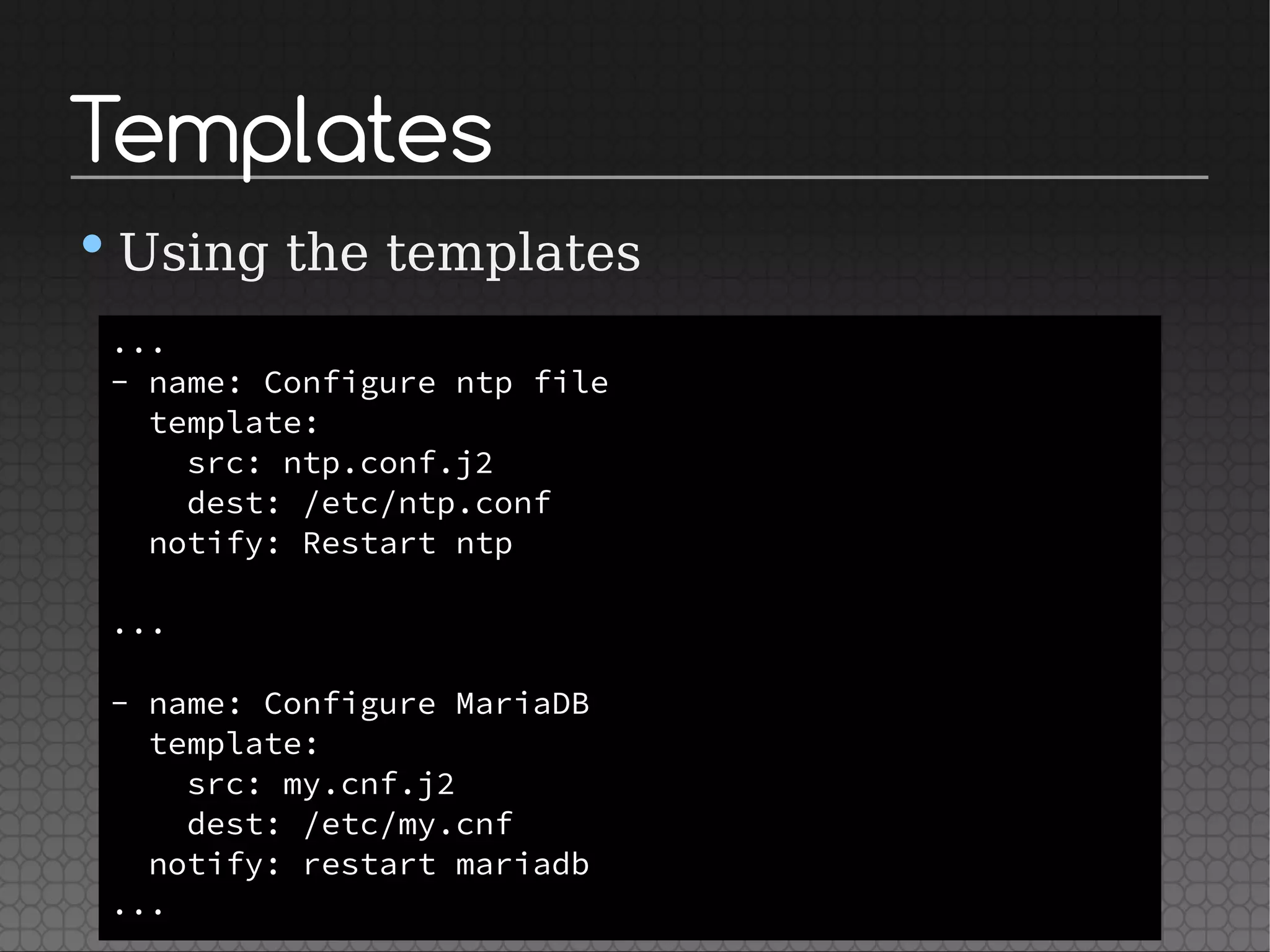
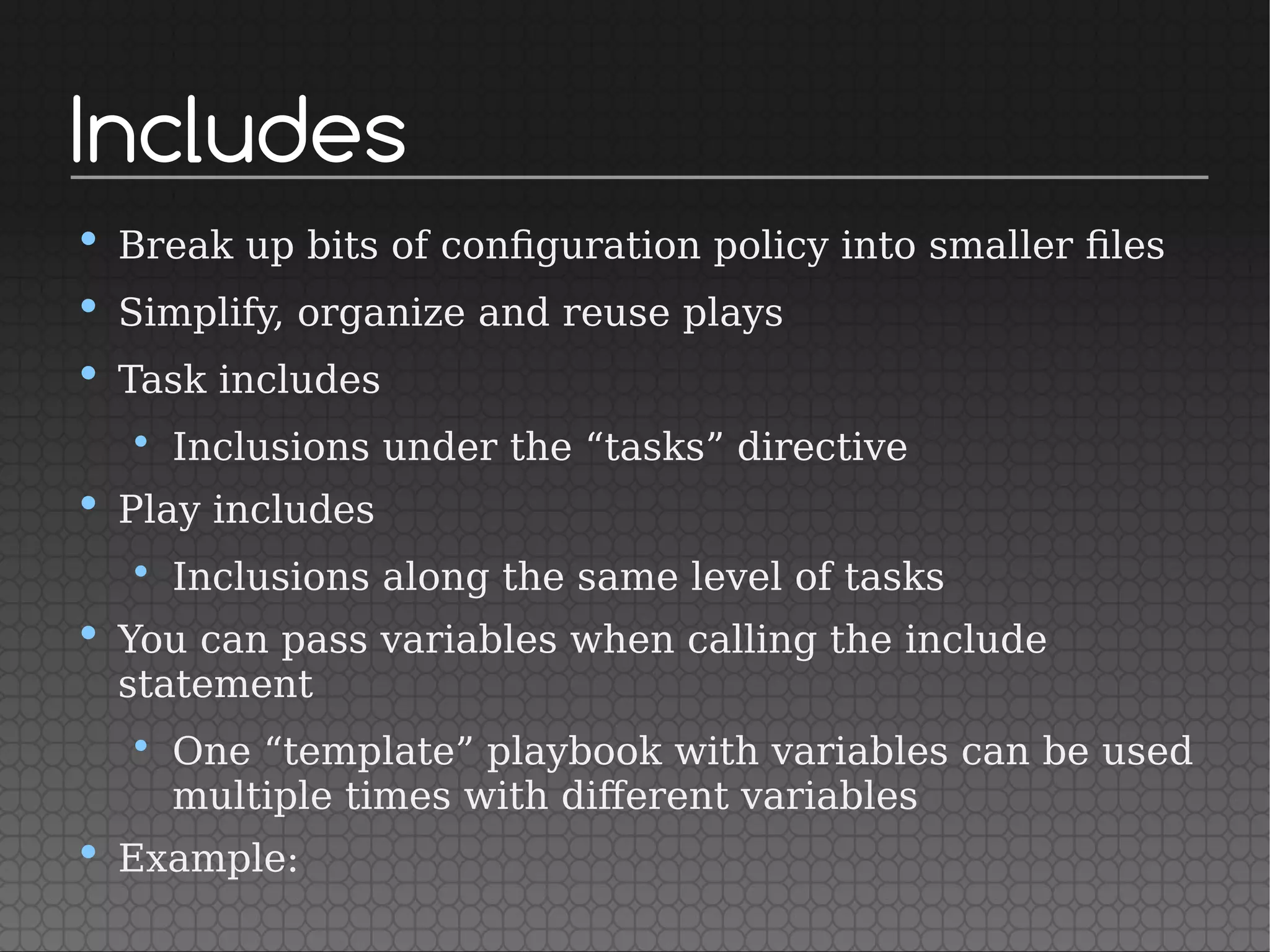
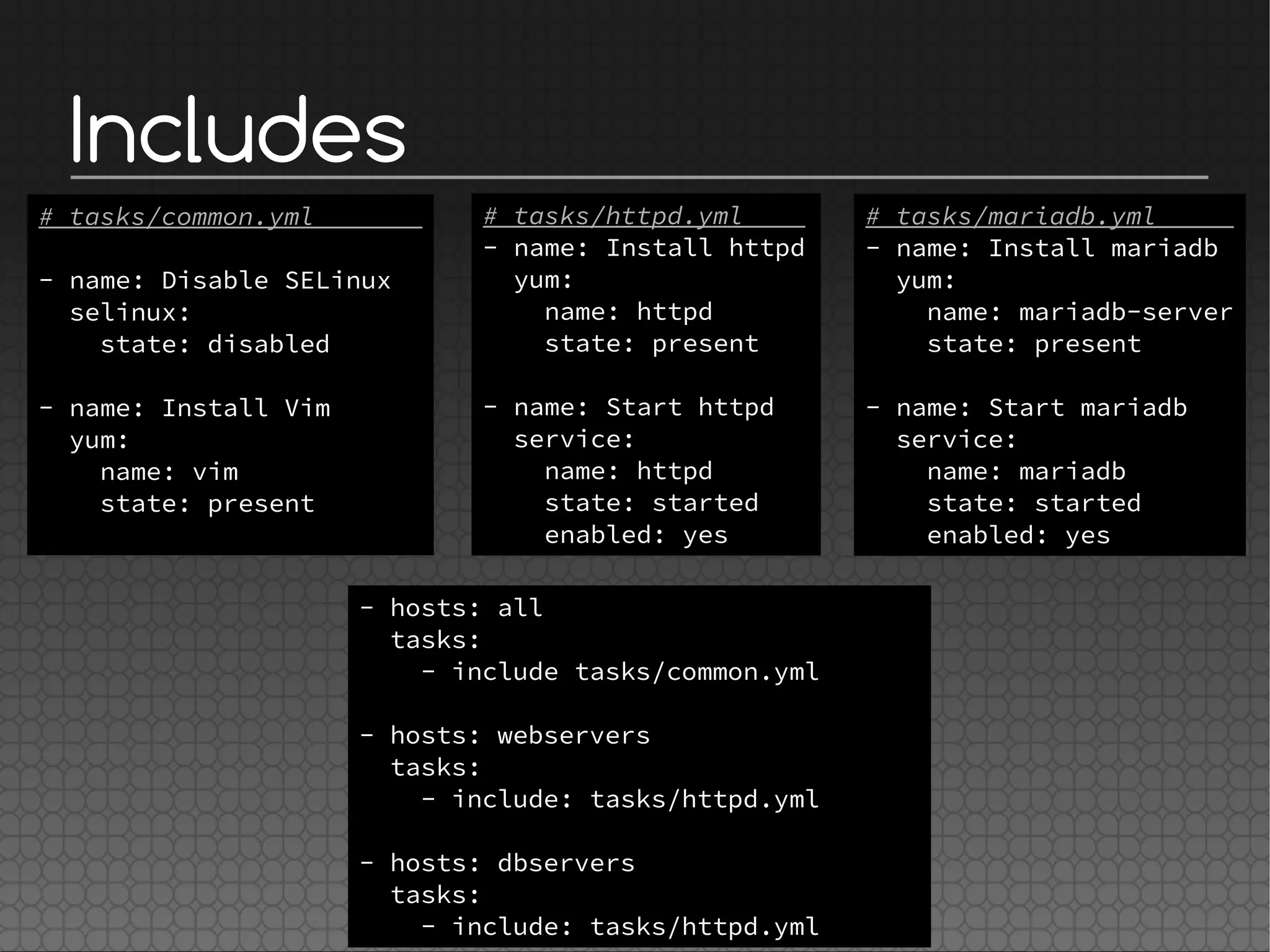

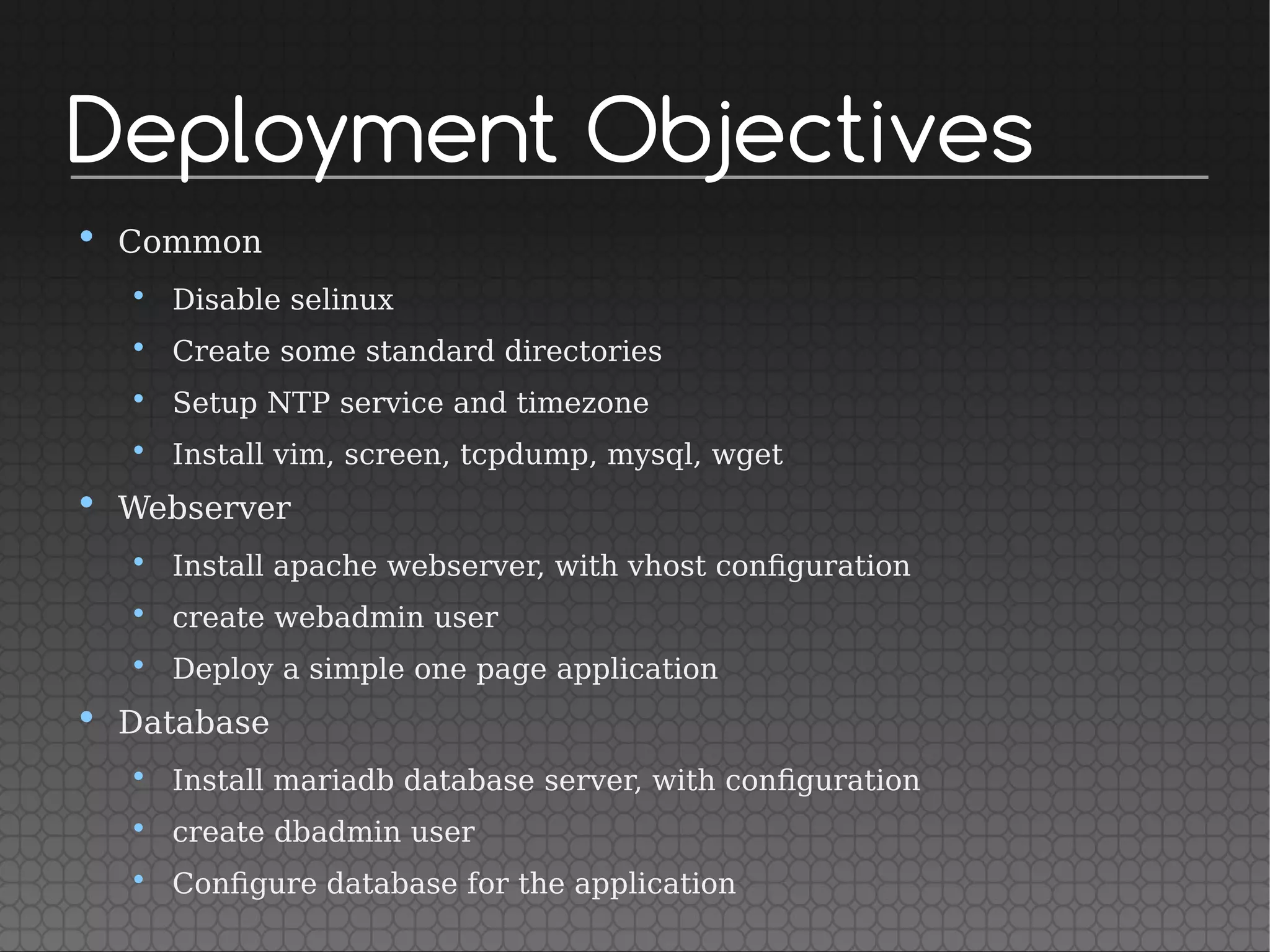
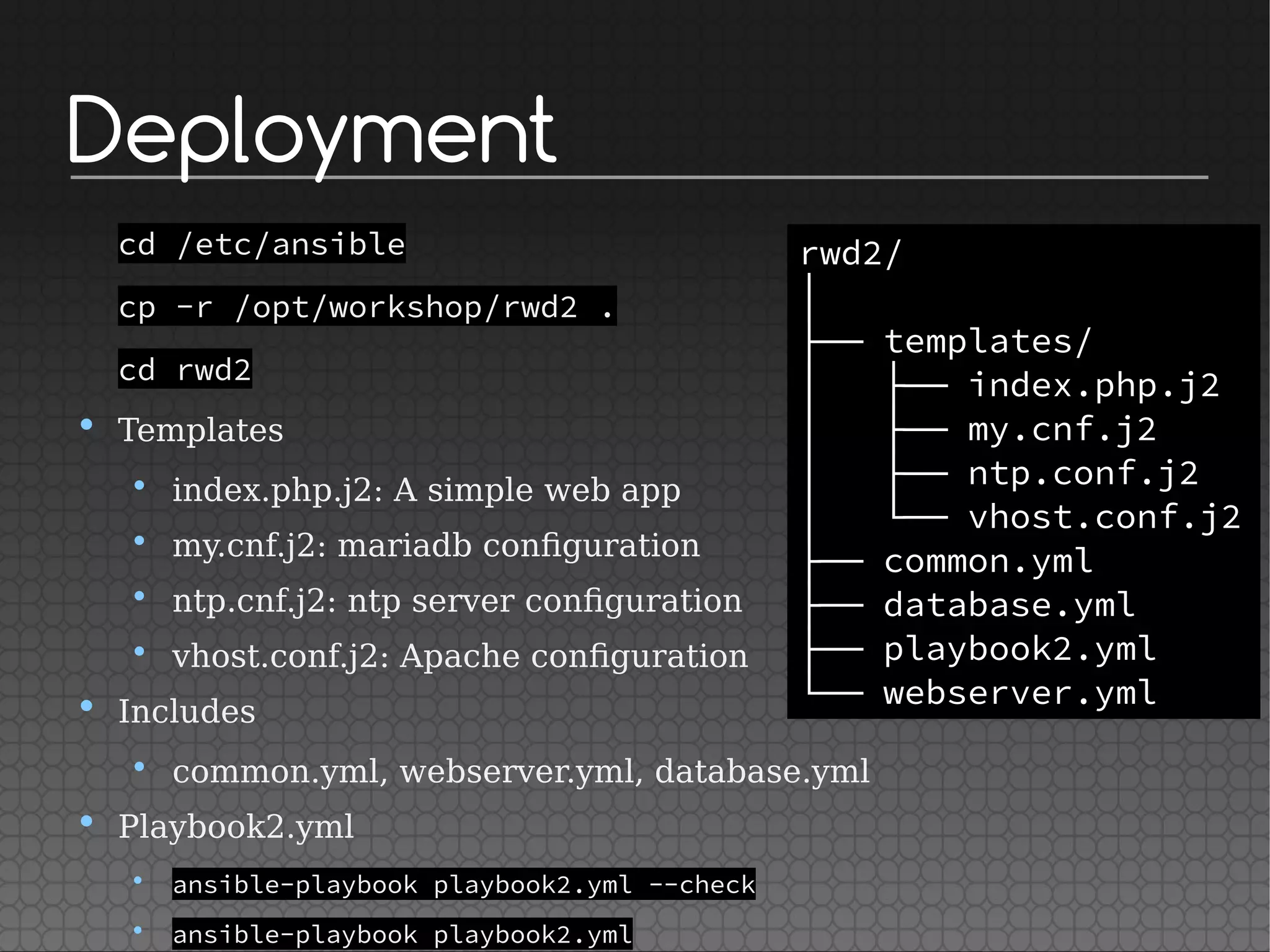
![[Break]
Questions?](https://image.slidesharecdn.com/automationwithansible-170723054153/75/Automation-with-ansible-61-2048.jpg)


